A Tiny Tale: One Little Boy's Road To Self Confidence
 Our morning routine is always the same. My kids wake up incredibly early (6 am), I try and convince them to go back to sleep, they stay awake, they watch cartoons while mommy sleeps until 7 am, momma makes breakfast, and I tell the kids to go get dressed.The last part of our routine has been a new addition. I used to pick out their clothes and tell them to get dressed, but now they've decided they want to get themselves dressed.My 5-year-old, Liam, reminds me he's too old for me to choose his clothes. Too old. He's five! I thought I had a few more years of being able to choose clothes for him, but no. He's fiercely independent and loves to pick out sports clothes each day and probably knows I'd pick a cute little hipster outfit instead.Levi, my 4-year-old, is no different. He started picking out his clothes much earlier than his unna (big brother) but loves choosing them none the less. I'll even attempt to lay out his clothes for him in the morning, only for him to bypass them and choose something else.While he doesn't typically choose to wear sports clothes, he has a unique style that completely fits his little personality. His outfit usually doesn't match and the clothes he chooses are never his own.He sneaks into his younger brother's stash of clothes and creates his little ensemble. At first, my husband and I would simply smile and tell him how proud we were of him. Then we started suggesting he wear his own clothes that actually fit his body.It soon became a huge challenge in the mornings to get him into his own clothes. He refused to wear his own shirts and was determined to wear a snug shirt that fit his baby brother.Last week, my husband finally sat him down to talk about it. While we assumed it was because he didn't like the fact his clothes were being passed down to his tam muddu (little brother) my husband discovered something quite different.
Our morning routine is always the same. My kids wake up incredibly early (6 am), I try and convince them to go back to sleep, they stay awake, they watch cartoons while mommy sleeps until 7 am, momma makes breakfast, and I tell the kids to go get dressed.The last part of our routine has been a new addition. I used to pick out their clothes and tell them to get dressed, but now they've decided they want to get themselves dressed.My 5-year-old, Liam, reminds me he's too old for me to choose his clothes. Too old. He's five! I thought I had a few more years of being able to choose clothes for him, but no. He's fiercely independent and loves to pick out sports clothes each day and probably knows I'd pick a cute little hipster outfit instead.Levi, my 4-year-old, is no different. He started picking out his clothes much earlier than his unna (big brother) but loves choosing them none the less. I'll even attempt to lay out his clothes for him in the morning, only for him to bypass them and choose something else.While he doesn't typically choose to wear sports clothes, he has a unique style that completely fits his little personality. His outfit usually doesn't match and the clothes he chooses are never his own.He sneaks into his younger brother's stash of clothes and creates his little ensemble. At first, my husband and I would simply smile and tell him how proud we were of him. Then we started suggesting he wear his own clothes that actually fit his body.It soon became a huge challenge in the mornings to get him into his own clothes. He refused to wear his own shirts and was determined to wear a snug shirt that fit his baby brother.Last week, my husband finally sat him down to talk about it. While we assumed it was because he didn't like the fact his clothes were being passed down to his tam muddu (little brother) my husband discovered something quite different.
"I like to wear tiny shirts, daddy because I'm tiny."
Levi has always been a little boy. He was our smallest newborn and has continued to have a smaller frame as he has gotten older. Little did my husband and I realize, Levi has been noticing how often people call him little and tiny.His friends will come over and call him tiny, adults mention his size, and all the while he's growing more insecure.As adults, we've all been there.We've struggled as children with insecurities and still struggle with them to this day. Now, we're watching our kids deal with them. It breaks my heart to see my kids look at themselves in any other way than I do.What can we do?How can I help Levi realize his size is temporary and his heart and character are what's important?
Show Him What Self-Confidence Looks Like
As a mom who has had three babies, I struggle with self-confidence. I look at my tired, stretched, and worn body and struggle to find the beauty.If I want to teach my kids how important it is to have self-confidence, it has to start with me. I have to show him what it looks like to be confident. I may not always be happy with what I look like, but they're my momma battle scars.My skin is stretched because I carried them all in my body.It looks worn because of every day I've been alive, living life with my family.I always look tired because I'm raising three boys under six years old.At the end of the day, beauty fades but self-confidence can last forever. I choose to be confident in who I am and what I look like. As I continue this process of being proud of who I am, my kids start to see it reflected in everything I do and say.
Help Him To Find His Unique Qualities
While my son struggles with his size, there are so many things he should love about himself.While he's small, his heart is big. He is one of the most loving and caring kids I know. He is always asking my husband and I how we're doing and asking if he can help us. He doesn't like seeing people around him sad or hurt. His heart is huge.It's important for us as parents to remind our kids of all the unique and beautiful qualties that make them who they are.We even go as far as having a 3:1 rule in our house. For every bad thing you say about yourself, you have to say three nice things. It can be uncomfortable to talk about things you love about yourself, but it shouldn't. We should be teaching them from the beginning of their lives to find out what they love about themselves.
How Do You Help Your Kids Develop Self-Confidence?
Raising Bilingual Kids When You Don't Speak Your Partner's Language
Are you raising a multiracial family? Do you want to teach your kids your partner's language, but don't know it yourself? Today Chontelle is joining us to teach you practical tips and tools to teach your child a second language. Chontelle Bonfiglio is an Australian living in Italy with her two bilingual children. She is a certified English Teacher, Writer, and Creator of Bilingual Kidspot, a website for parents raising bilingual or multilingual children. To read more on Bilingual Parenting, follow on Facebook
Raising bilingual kids can be difficult when you don’t speak your partners language.
It can sometimes feel like you are isolated from family conversation. When your partner and children are speaking together and you have no idea what they are talking about, and you don’t know how to join in, it can be frustrating. But, know that you are not alone. It is actually more common than you may think.Many bilingual families have one parent who is monolingual and it can sometimes affect your relationship, and also your relationship with your children when you can’t all speak together in the same language. However, there are ways you can make it work.From speaking to parents in this situation, here are the most common suggestions:
Be open with each other and discuss your feelings
It is important that you discus how you are feeling with your partner. After all, you are in this together. If you have spoken in the past about how you wanted to raise your children, it has no doubt come up before, and if not it was bound to.It is important that you are on the same page, making your parenting decisions together, and deciding on a language strategy that works for you.
Have your partner translate when talking as a family
What many families do is translate while having a family conversation. I don’t mean every single sentence, but at least the idea of the conversation.I do this when I am with my in laws who don’t speak a word of English. I do feel guilty when I am speaking to my kids in front of them, and since we follow OPOL, I never speak Italian with my kids. So every now and again, I will translate and summarise the conversation for them so they don’t feel left out.It can break the conversation, and disturb the flow. However you will probably find, that initially lots of translating is needed. Then as you go on, a little less because you will start to understand what is being said, even if you cannot speak the language.
Consider having a family language
Considering this option depend on where you live and what the community language is. I would only recommend having a family language in the case where you are the parent who speaks the minority language. You could follow the Minority Language at Home approach.If however your partner speaks the minority language, it could make things a little more difficult. The minority language is the language which needs the most exposure, therefore could take that well needed exposure away. If you do decide to have a family language in this case, your partner will need to make sure to be consistent. And, ensure that they have a lot of one on one time together with the children speaking the minority language to keep it up.
Make compromises together
Compromises are vital when you don’t understand your partners language and working together is important.Things like watching movies together may be difficult. A compromise could be watching a family movie together in their language, but with subtitles so that you can also understand. This will also help you learn a bit of the language too.Another compromise could be having a certain part of the day where you all speak your language together. Perhaps at bedtime, reading a book together or taking turns singing songs together in each language.
Think about learning the language yourself
When I met my husband I couldn’t speak Italian. We lived in Rome where I was able to get by with English, but when we went to stay with his family in the south it was another story. I constantly felt out of conversation as I had no idea what anyone was saying.When we decided to raise a family it was a huge issue for us, because I was so afraid of being isolated, and not being able to understand my children. I made the decision to learn Italian when my first son was born.You would be surprised at how easy it is to pick up new words when speaking with children. People tend to speak simple sentences and slower when speaking with kids, so by making an effort to listen to what your partner is talking about with your kids you may learn quicker than you think.You don’t have to be at the point where you can have a conversation. But, at least getting the gist of what is being said will make you feel less isolated.Over the years I have learned to speak Italian along with my children and while I am still not completely fluent, and may not ever be, I feel better being able to join in a conversation with my family.
Raising Bilingual Kids is a team effort
Raising bilingual kids when you don’t speak your partner’s language means you need to be flexible and work together. It really is a team effort. The important thing is that you are open and you speak with your partner when you feel upset, or isolated. Family communication is important. If raising your children bilingually is important to you, then you must both be prepared to compromise along the way.
Follow Chontelle Along On Her Family's Bilingual Adventures
Multiracial Motherhood: How We Celebrate Multiple Cultures In Our Family
I'm very excited to be continuing our Multiracial Motherhood series this morning. So far we've walked along the journey with Sara and Larisha. They've shared a bit about their family with us and what they've learned in raising a multiracial family. Today, Becky from Kid World Citizen is joining us! There family has traveled the world to make sure their kids are raised with a global mindset and today she is teaching us a few of her secrets. 
Meet Momma Becky!
My husband and I met when he was an exchange student from Mexico spending a year at University of Illinois, while I was a student there. I had just returned from a semester in Spain and was matched up with a "buddy" exchange student who I was supposed to show around.From the moment I met Toño at our welcome picnic, we were instantly drawn to each other. Despite huge language barriers, we managed to talk for hours about everything under the sun. It was such a fun semester of studying, dancing, and running together.Thanks to long-distance phone calls, trips between the US and Mexico, and a lot of patience and love, we got married in the year 2000. Our 5 kids have joined out family in different ways. First, we had our 2 sweet biological daughters: the loves of our lives, who make us smile every day... but we knew our family was't complete. We adopted our oldest sun when he was almost 4, and his contagious, playful smiles instantly endeared us to our playful son. We decided to expand our family again when we adopted Ricky from Ethiopia. An inquisitive ball of energy, Ricky injected our family with a spirit of curiosity. Two girls, two boys, and we were a balanced, happy family--- but we still had this little voice telling us that we weren't complete.As we rode the roller coaster of becoming foster parents, we met our bundle of exuberant, intense joy: Mario. There is not a person who meets him who doesn't fall in love with this little ham.Having so many diverse cultures forming the foundation of our family has been incredibly enriching. We try to celebrate and honor our heritage cultures both in big ways (such as important holidays) and also little ways (through cuisine, home decor, books, etc).
We adopted our oldest sun when he was almost 4, and his contagious, playful smiles instantly endeared us to our playful son. We decided to expand our family again when we adopted Ricky from Ethiopia. An inquisitive ball of energy, Ricky injected our family with a spirit of curiosity. Two girls, two boys, and we were a balanced, happy family--- but we still had this little voice telling us that we weren't complete.As we rode the roller coaster of becoming foster parents, we met our bundle of exuberant, intense joy: Mario. There is not a person who meets him who doesn't fall in love with this little ham.Having so many diverse cultures forming the foundation of our family has been incredibly enriching. We try to celebrate and honor our heritage cultures both in big ways (such as important holidays) and also little ways (through cuisine, home decor, books, etc). We've learned that in the hustle and bustle of carpooling and swim team, homework and housework- sometimes the easier route would be to let time pass by without a mention of our backgrounds. But- and we are not perfect- we have to consciously try to always make our cultures an integral part of our daily lives by having friends from diverse backgrounds, choosing a neighborhood that reflects our family's cultures, and having open communication with our kids about race, ethnicity, and what it means to be growing up as "x" in the US.My advice to other multiracial families would be to embrace and learn about your loved ones' cultures as much as you can, so that you end up creating your own family culture that is a blend of customs and traditions from both sides.
We've learned that in the hustle and bustle of carpooling and swim team, homework and housework- sometimes the easier route would be to let time pass by without a mention of our backgrounds. But- and we are not perfect- we have to consciously try to always make our cultures an integral part of our daily lives by having friends from diverse backgrounds, choosing a neighborhood that reflects our family's cultures, and having open communication with our kids about race, ethnicity, and what it means to be growing up as "x" in the US.My advice to other multiracial families would be to embrace and learn about your loved ones' cultures as much as you can, so that you end up creating your own family culture that is a blend of customs and traditions from both sides. Finally, if at all possible, travel and immerse yourself to truly learn about your partner's background, language, and really the heart and soul of what makes them who they are. Our family has bonded so much by traveling together, while developing a pride in and love for each others' countries.It's this love and respect that builds us up and helps us support each other.
Finally, if at all possible, travel and immerse yourself to truly learn about your partner's background, language, and really the heart and soul of what makes them who they are. Our family has bonded so much by traveling together, while developing a pride in and love for each others' countries.It's this love and respect that builds us up and helps us support each other.
Follow Becky along on her journey here!
Our Multiracial Family Mentors
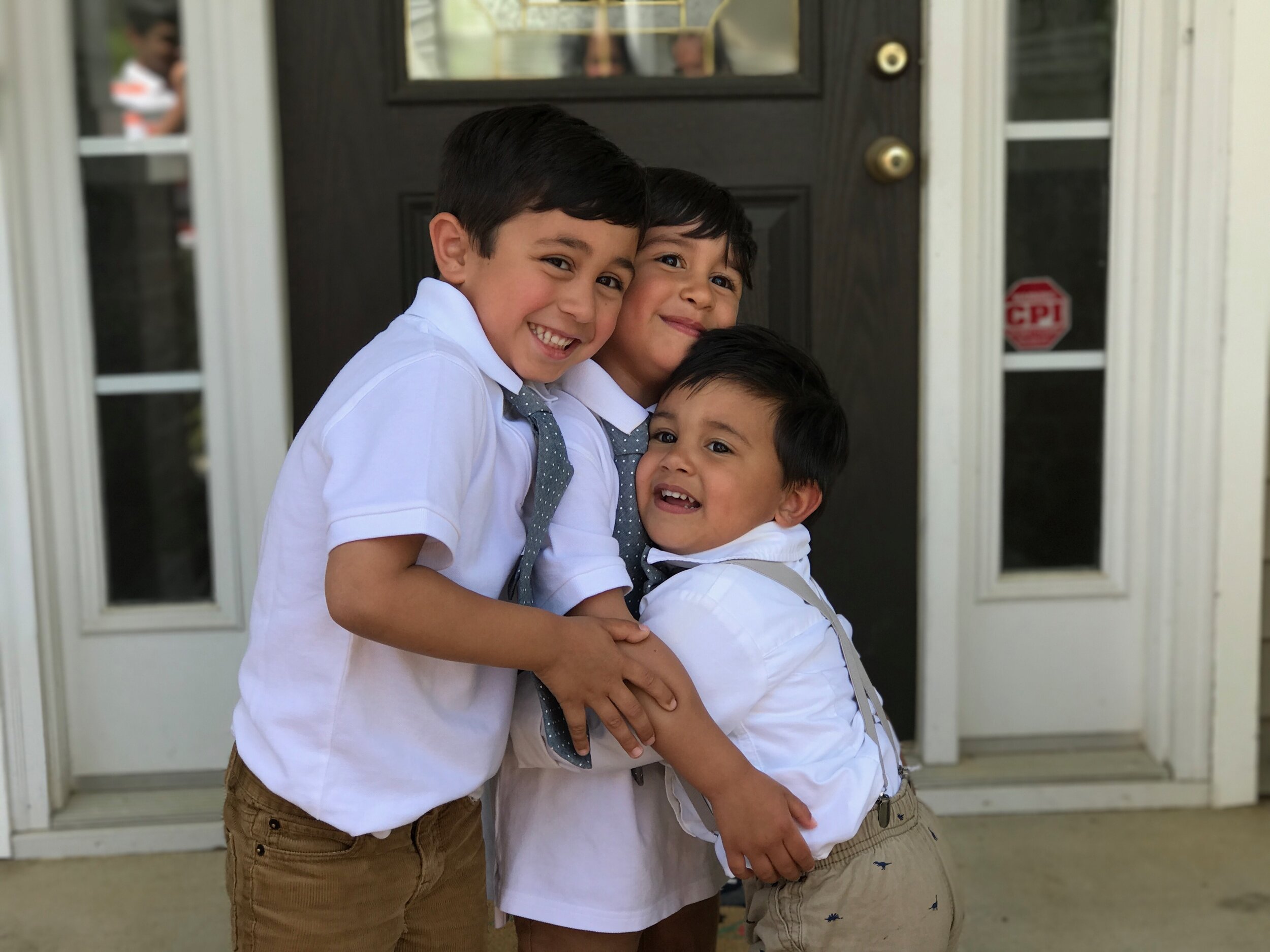
Holidays are full of chaos and sweet memories in our family.
What can you expect when you get so many people together in one home!Easter this year was no different. As most of you know, we recently moved to North Carolina which sadly is only further away from family. We absolutely love my husband's job change, as it means he hardly ever travels anymore, but being away from family is hard.Throughout our marriage, my husband and I have always lived by one side of our families. It's changed over the years as we've moved around, but family was always there.Now, the closest family member is about 8 hours from our home. We're no strangers to road trips, so I see plenty of road trips over the summer to spend time with the kid's uthas, chininas, uncles, and nanamas.In the meantime, we definitely miss everyone. This is why Easter was so special this year. My husband's pinni, uncle, cousins, and mom came to spend the holiday weekend at our new house!We were so excited to show everything off and show them the new town and home we've fallen in love with.Our home was bustling with people all weekend and it truly made our new house feel like our home. My husband and I love having family stay with us!One of the best parts of the weekend was seeing our kids spend time with their uthas and chinina (cousins).They are being raised in a multiracial family like my kids are and I'm always so encouraged watching them. Their parents have made such a strong effort to blend Eastern and Western culture within their family. They've always been our go to family for advice on how to blend. They've been doing it for 22 years!Sometimes I lay in bed at night wondering if I'm doing it well enough.I get worried I won't be able to bring Indian culture into our family as much as I want it to be.I worry my kids won't truly understand how rich and beautiful Indian culture is.Then I see their cousins and see that it's possible. They have a deep love for both cultures. It may be shown differently, but it's there. As they get older, their pride for both cultures only gets stronger.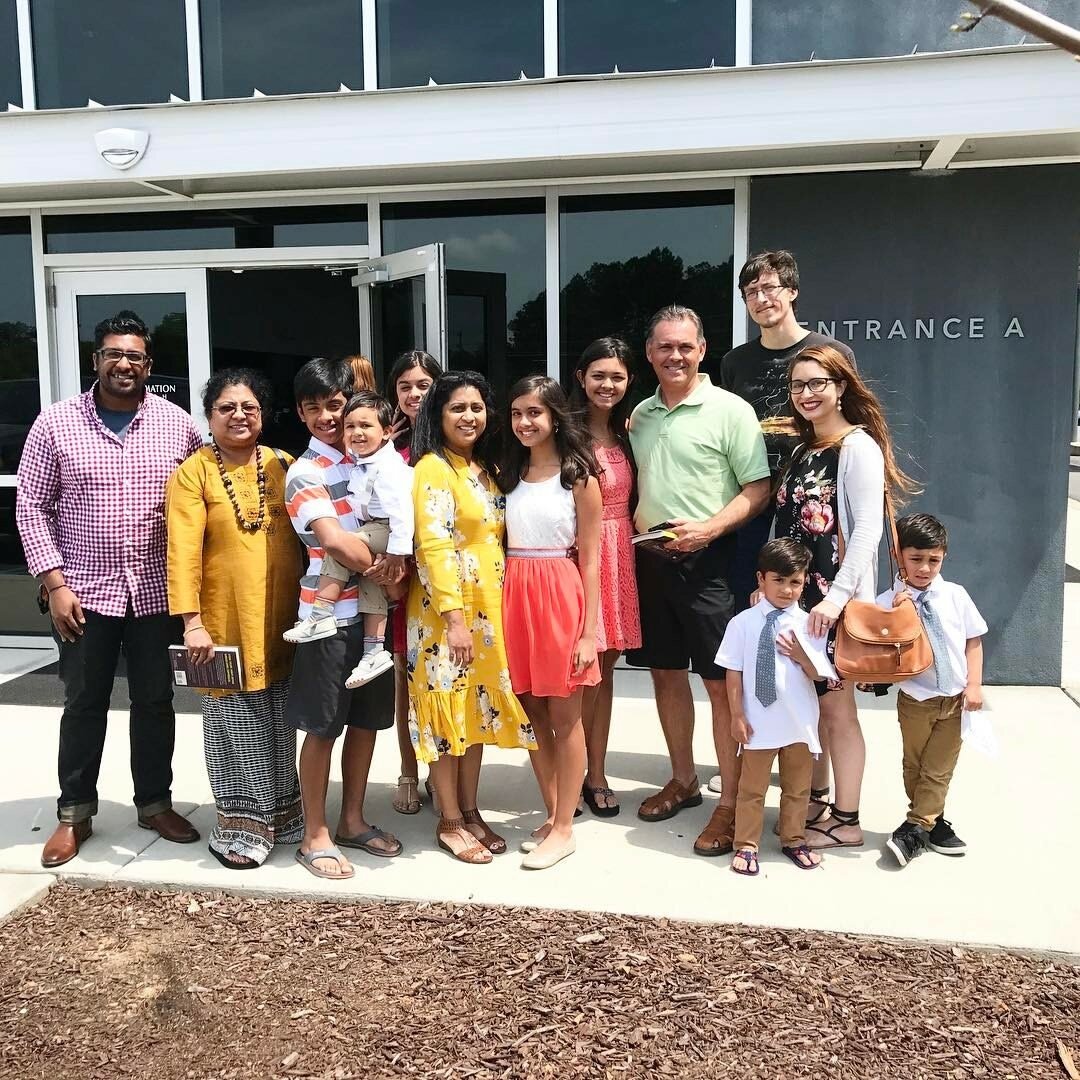 What are their secrets? What have they done throughout their kid's lives to make this a reality?
What are their secrets? What have they done throughout their kid's lives to make this a reality?
Travel
They have traveled to India as a family multiple times. It seems simple, but spending time in India takes what they've learned from their parents about Indian culture and takes it to the next level. There's only so much you can say and at a certain point you have to show them.Our family has yet to take our kids to India as my son is dealing with health issues, but we save every year so that we can make it a reality. We want to show our kids what it looked like for daddy to live in India.Traveling to India isn't just for the kids, it's for our marriage too. I want to see India and actually spend time there. I want to experience India with my husband.
Food
If you glance in their fridge or pantry, you'll see traditional dishes for both cultures and fusion dishes. You can look at the table and see one kid eating a samosa, one eating a mango, and one eating a peanut butter and jelly sandwich. Their kids are comfortable with both cuisines and I love it.We try and do the same with our kids. Our staple meals consist of keema curry, pasta, burgers, and chicken tikka masala. I do the best I can to make sure both cultures are represented throughout the week in my meal plan. Although if it was up to me it would be all Indian food because I'm obsessed!
Open Minds
This couple is completely open to their spouse's culture. While Pinni grew up in India, she has no problem embracing her husband's family culture. She wants him to know she values and loves his family, culture, and everything that has made him the person he is today.The same can be said about the way he treats her. He travels with her to India, he wears traditional Indian clothes, and makes sure his kids use the appropriate Indian terms for family members.The best part is that he has taught me so much about what it means to embrace Indian culture. He has been my go to person for advice so many times.Having an open mind in a multiracial family is vital. There are going to be so many times your culture will push you towards different directions. You and your partner have to be open to trying things a different way.
Do you have a multiracial family in your life that you look up to? What have they taught you?
3 Ways To Blend Cultures Without Losing Your Identity

"We don't need a melting pot in this country, folks. We need a salad bowl. In a salad bowl, you put in the different things. You want the vegetables- the lettuce, the cucumbers, the onions, the green peppers- to maintain their identity. You appreciate differences."
- Jane Elliot
Let's Throw Out The Melting Pot!
I love this quote. I've always heard of America as a melting pot of different cultures. As a child, I didn't think twice about it because it made sense. Now that I hear it as an adult, it doesn't sit well with me.A melting pot means we all melt together and conform to the same thing. If America is a melting pot, then we're expected to keep the parts of our cultures that everyone is comfortable with and let the other things go.It brings me back to a question I get asked by many of you.
Now that I'm in an interracial relationship, do I have to lose my culture and conform to theirs?
No. Simply no.When your partner fell for you it was because of who you are, not what someone wanted you to be. Your culture and life has helped you to become the person you are today.As we begin blending cultures, some people go back to the melting pot idea. They think you have to melt all of your culture, traditions, and life together with your partners until it becomes something brand new. In reality, one of my favorite things about a multiracial family is that you're bringing together two distinct cultures.Over the last seven years, my husband and I have found ways to bring in traditions we both grew up with, parenting styles we had, and new customs unique to our own little family.When we first got together, there was a part of me that assumed I was expected to let go of my own culture. Some of it was my own idea of what I was supposed to do and some of it was expectations from other people.It took me a while to realize I had to put the melting pot aside because it wasn't working for my relationship or family. My husband was actually the big reason for this. He had been telling me from the beginning I wasn't expected to do anything I didn't want to do. If other people wanted those things, it was up to me to decide what I was comfortable with.As many of you know, culture expectations can be a heavy burden, but at the end of the day it's our choice. We can choose to conform to different expectations or we can find a different way.Our identity is made up of more than just our traditions. Our identity is who we are at the end of the day. As you're sitting here reading this, think about what's made you who you are today.You are who you are because of the decisions you've made, how you grew up, the influences you've had in your life, your culture, and so much more. Our identity truly does change over time.The identity I had before kids compared to now is different and I don't see it as a bad thing. It's because the love you have for your children changes you.As you get into a relationship, your identity changes because you start to care about someone and make room in your life for them. As you blend cultures, the same thing will happen, but it doesn't mean you have to lose your identity. You will develop a passion for this new culture and you'll notice you want to bring it into your life and family.If we can throw away the melting pot, the fear of losing ourselves to this new culture goes away. Our little salad bowl will contain the best parts of both of our cultures.
What can you do to make sure your relationship is a blend of two cultures?
Communicate
I can't ever say this one enough. Communication is so important. You need to talk to each other and let your partner know how you feel. They can't read your mind and if you don't speak up, nothing will change.
Check in with each other
Sit down with each other and discuss your relationship. Obviously, this will probably happen throughout the week as well, but make sure you're intentional about it at least once a month.Then you create a safe time to discuss how you're feeling. Whether this is how their family treats your traditions, how you feel blending cultures is going in your relationship, etc.Things change. An area of your relationship can be going great one month and struggle the next. Make sure you are always reevaluating together.
Make a list
I know this one might sound silly, but it's not. Make a list of things that are important in both of your cultures. Then you can think about how to make those things present in your lives.We currently don't live by my husband's family. Our kids don't get to see all of the Indian customs and traditions on a daily basis. Knowing what my husband wants his kids to know and follow based on his culture helps us find ways to intentionally incorporate it into our daily lives.Blending cultures is beautiful because it's bringing two people together and finding the best of both.
How do you make sure your family is a good blend of you and your partner's cultures?
Raising Our Kids To Have Hope In A Scary World
 Every night this week, my husband and I have fallen asleep watching CNN. We can't pull ourselves away from it. We listen to the latest news on our Syrian brothers and sisters, we try to find out what our country is going to do next, and we try to figure out what to say if our kids ask questions about any of it.Now that our kids are getting older, they're finding out about the world from their friends. My kids and their friends overhear something their parents talked about the night before and go to each other's houses to tell their friends their own versions. Sometimes it's scarier than what it really is and other times it's dead on.I wish I could prevent my kids from hearing about all the scary things going on in the world, but it's the one thing I can't shield them from.Life has an endless supply of scary stories and as my kids get older, they're only going to gain a better understanding of what's actually going on.So what can we do as their parents?
Every night this week, my husband and I have fallen asleep watching CNN. We can't pull ourselves away from it. We listen to the latest news on our Syrian brothers and sisters, we try to find out what our country is going to do next, and we try to figure out what to say if our kids ask questions about any of it.Now that our kids are getting older, they're finding out about the world from their friends. My kids and their friends overhear something their parents talked about the night before and go to each other's houses to tell their friends their own versions. Sometimes it's scarier than what it really is and other times it's dead on.I wish I could prevent my kids from hearing about all the scary things going on in the world, but it's the one thing I can't shield them from.Life has an endless supply of scary stories and as my kids get older, they're only going to gain a better understanding of what's actually going on.So what can we do as their parents?
Answer Their Questions Appropriately
Kids are going to ask questions because it's their way of trying to make the world a little less scary. If we don't answer them they're only going to go to their friends with the same questions, but their friends aren't going to have the answer we want.We need to think through how we can answer scary questions they have appropriate to their ages.Mommy, what happened in Syria?
- There is a bad leader in Syria doing things to scare and bully his people. Now a lot of citizens there are looking for a safe place to live.
- There is a leader named Assad there and he is using his power to scare and hurt citizens in Syria. Recently he did something that hurt a lot of people.
Find a way to answer your children's questions that provides information without overwhelming them.
Find Hope
Fear without hope is a terrifying feeling. As parents, it's our job to find hope in the scariest of situations. Our kids are coming into a scary time in the world, but they're also the ones that will make a change when it's their time to shine.We need to raise hopeful kids so as they grow into adults, they will always look for ways they can affect change.One way we can do this is by finding a way to do something as families. We could serve at a local shelter, raise money for a group in need, or raise awareness. Start with something small and show them they can make a difference in the world they live in.
Fight The Scary Monsters
We have been there to scare away the monsters for our kids since their first bad dream. Now, they're learning the monsters aren't only in their dreams, but in the world they live in.When our kids thought they saw a monster, we would go in gallantly. We'd look under the bed, in the closet, and maybe even "fight" them off.Now, it's their turn. They get to learn how to fight off the scary monsters in the world. How can they do it? By standing up firm and telling the monsters they can't take our hope away. They can stand big and tall, try to scare us, but they can't take our hope.We can teach our kids never to give up, no matter how big the problem is.We can teach them to always stand up and fight.
How Do You Teach Your Kids About A Scary World While Giving Them Hope?
Can I Get An Interpreter Over Here?
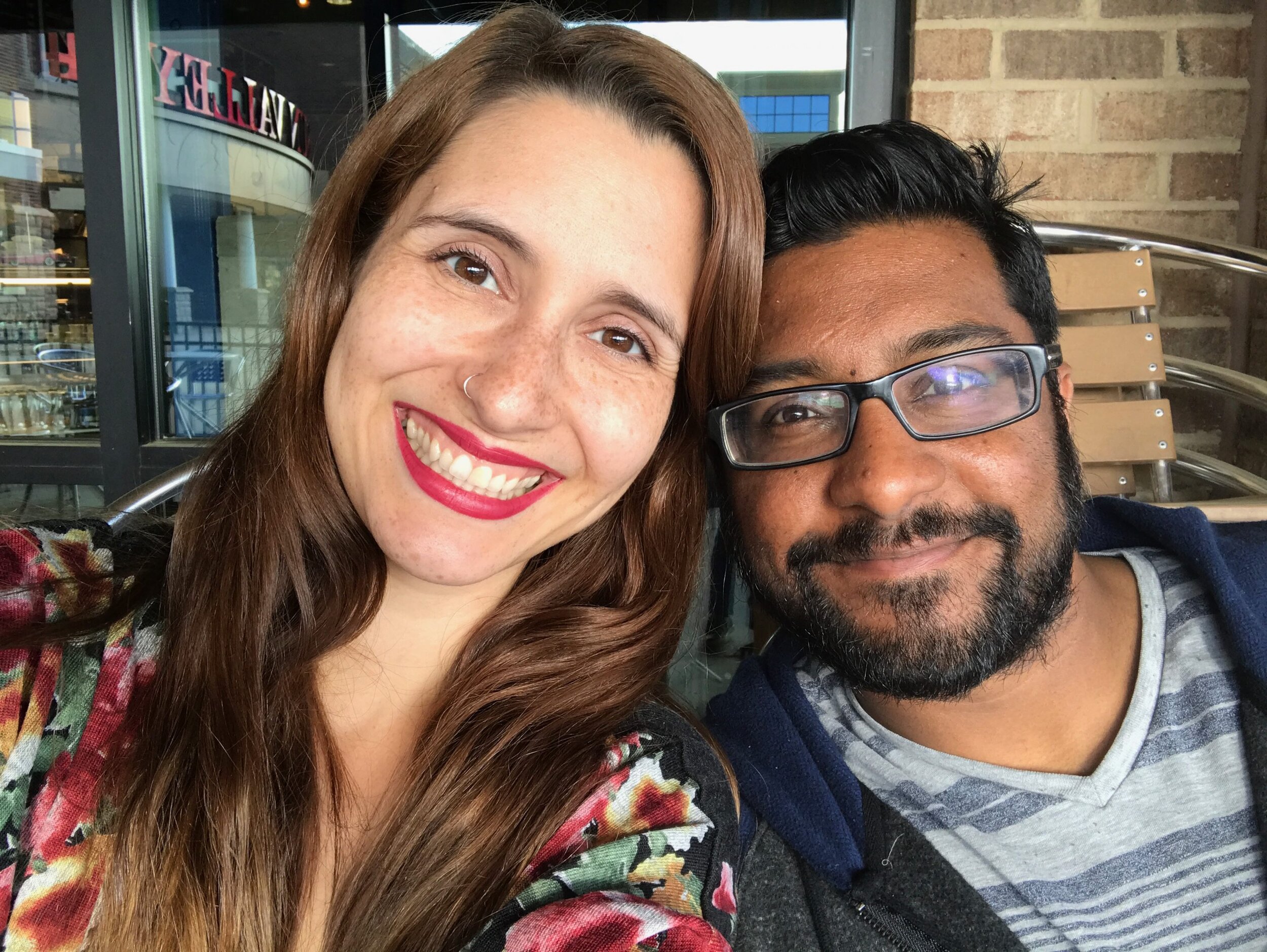 When my husband and I first met, we were doing an internship with our church. It was an amazing experience because we learned so much about ourselves during the program and of course met each other.The first time my husband saw me, I was interpreting for one of our morning classes. I had learned sign language the year before and helped out when I could by interpreting classes for my friends in the program.Learning sign language was amazing. It wasn't just the language I had learned that year, but I was introduced to deaf culture as well. I learned about deaf etiquette, how to interact with the deaf community, and how to blend cultures when the deaf and hearing community were together.
When my husband and I first met, we were doing an internship with our church. It was an amazing experience because we learned so much about ourselves during the program and of course met each other.The first time my husband saw me, I was interpreting for one of our morning classes. I had learned sign language the year before and helped out when I could by interpreting classes for my friends in the program.Learning sign language was amazing. It wasn't just the language I had learned that year, but I was introduced to deaf culture as well. I learned about deaf etiquette, how to interact with the deaf community, and how to blend cultures when the deaf and hearing community were together.
While I didn't know it at the time, I was preparing for a life of blending cultures for my multiracial family.
There were times throughout my internship where I would be sitting with my friends and signing for hours. If it was just my friend and I, hours would go by without me using my voice once. There wasn't any need to use my voice as long as I was mouthing the words. I was fully submerged into my conversation and didn't think twice about talking out loud.If someone that didn't understand sign would walk into the room, I immediately started voicing our conversation. I'll be honest, it took a lot of reminding because I assumed people around me understood. It became a routine that year for my deaf friends and I. I usually didn't mind, but there were times I just wished everyone knew the language. It took a lot of effort for my deaf friend who wanted to speak to everyone and I wished it could be easier for her.
Just about a year later, I was on the other side of the table.
My husband and I were getting married and we flew to Chicago. We decided to get married by his family so we could truly have a blended wedding and be able to incorporate both cultures.I'll never forget the first few times I would sit at a table without understanding a word that was spoken in front of me. My husband did his best to interpret, but he was just learning like I had the year before. It wasn't natural to him yet, so I often had to nudge his arm and ask what people were saying.I finally understood how frustrating it is to have people have a full conversation in front of you without being included. Honestly, it was painful. I felt like I was back in middle school, being left out from the group.
While I know now it's rarely intended that way, it's still uncomfortable.
You start making up conversations in your head, trying to guess what they're talking about. It makes it so much worse if you don't get along with your inlaws. Then you pick up on the few words you do know like "thella pilla" which means white girl.During my wedding, it was the first phrase I learned. I was joking with my husband and his cousins. I was laughing saying I bet everyone is talking about me and all of the things I'm doing wrong. They laughed and let me in on a little secret.Don't worry, you'll know when they're talking about you. They'll look straight at you and you'll hear "thella pilla."
A crash course into the Indian community!
I'm almost 8 years into my interracial marriage and I still encounter those uncomfortable moments. I don't know the language like I wish I did. I know bits and pieces so my imagination runs away before I can stop it.Most of those experiences have been because family is together and it feels comfortable for them to speak in Telugu. They grew up speaking it and I can only imagine it feels like home when they gather around the table telling jokes in Telugu. Those are the moments I ask my husband to interpret because I want to be a part of the group.Then there are the moments where people purposely speak another language in front of you so you don't understand. I still ask my husband to interpret, even if I can see the body language in the room is saying I probably don't want to know what's being said.
At the end of the day, if I truly want to be included in all of those conversations I have to learn the language.
I can't expect them to not speak Telugu in front of me, just like I wouldn't expect my deaf friends to stop signing.It's their language and no one can ask them to stop speaking it. I can, however, ask for my husband to be my built-in interpreter. sometimes it serves as a reminder for people to use English more so my husband doesn't have to. Or they start interpreting for me as well as teaching me what little words mean.
Have you ever been the only one at the table who doesn't know the language? What did you do?
Simple Ways To Encourage A Strong Sibling Relationship
Simple Ways To Encourage A Strong Sibling Relationship
I always knew I wanted to have multiple kids. I loved growing up in a house with siblings. You always had someone to play with and an instant team to do anything with you!Even though we were enemies half the time, I look back and remember how we were there for each other through thick and thin. We could yell at each other, but the second anyone else attempted to, we were there within seconds.I look at my little boys now and know I want the same thing for them. I want them to be best friends that can make it through anything together. I know it's going to take a lot of time and effort to build that relationship, but it's worth it.Here are a few simple things you can do with your kids to help them have a strong relationship.
Encourage Your Kids To Be Each Other's Fan Club
It's easy for siblings to start comparing themselves to each other. They see how good their sibling is at something and wish they could be better. Stop this in it's tracks by encouraging your kids to cheer each other on rather than compare.When their sibling has a big game, go out as a family and cheer them on together. Make sure your kids know how important it is to be their siblings number one fan!
Don't Make Them Do Everything Together
As parents, we want to make things as easy as possible. In doing so, we tend to lump our kids in to the same activities. While it makes it easier for mom's carpooling, it isn't necessarily better for our kids. Our kids have different strengths, passions, and desires. We need to help them to find what it is that makes them happy.When we make our kids do every thing together, it fosters an environment for comparison. By allowing our kids to do different things, we're teaching them to take pride in their unique strengths and passions.
Encourage Them To Be A Protective Unna
One of the biggest lessons we teach our kids is to be a protective unna (big brother). As an older sibling, it's their responsibility to look out for them. This may mean making sure they don't get into too much trouble, standing up for them, or even pushing them to be the best little boys they can be.It may seem like a lot of pressure, but this looks different at every age. As little kids it may just mean helping each other out. As they get older, it will look different again.
Teach Them To Ask Each Other For Help
Often times, one of the last things you want to do is ask your sibling for help. Asking their sibling for help makes them vulnerable. It's vital for your kids to feel comfortable being vulnerable in front of each other.They can be each other's biggest allies in life. If they learn to ask each other for help when they're little, they're going to continue relying on each other as they get older.
Encourage Your Kids To Be Kind
Help your kids find opportunities through out their day to be kind to their siblings. It doesn't have to be a monumental gesture, it can be simple. Teach them to find moments to be selfless and do something to help their sibling.They can find their siblings coat, help them clean up a mess they didn't make, or give them a hug when their sad.
What do you do to help your kids have a strong relationship?
Pin For Later
Easy Indian Spiced Sweet Potato Bowl

Blending Cuisines In The Kitchen
When my husband and I first got together, I didn't know how to cook to save my life. I could make a few simple dishes, but for the most part I was at a loss.I decided to try and learn from the best. I collected recipes from my aunt, mom, grandma, and even my husband's side of the family. I was determined to figure it out. In the beginning, I followed the recipes to the letter. I didn't know where I could experiment or flavors to blend.The more I made the same dishes over and over again, the more confident I became. I knew how it was supposed to taste and became inspired to try new things with it.Then I started to notice how cuisines started blending together in our dishes. Indian food uses a lot of ginger garlic paste, chili powder, and turmeric. It became a staple in our house so I slowly started to incorporate it into my own family recipes.The results were mouthwatering. This is exactly why fusion restaurants are HUGE. Blending certain spices together that don't typically get paired is a delightful surprise to your taste buds. Today, I decided to experiment in the kitchen for lunch and it turned out to be more delicious than I had expected! Before my kids could even finish their bowls, they were asking when we could make this dish again.
Today, I decided to experiment in the kitchen for lunch and it turned out to be more delicious than I had expected! Before my kids could even finish their bowls, they were asking when we could make this dish again.

Pin For Later

12 Things You Understand If You're Mixed Race

1. You know your parents are angry when they yell at you in a different language
2. Friends felt awkward at your house
3. People assume you aren't related to your parents
4. Fusion food was normal in your house
5. Your family can't ever agree on how spicy food is
6. Only half of your family thinks they need sunblock
7. People will ask you questions all the time
People are constantly asking you questions about your ethnicity and family.
8. Filling out forms gets a little confusing
9. Explaining your name to people
10. Having to hear "it doesn't count you're only half"
11. Over people trying to guess your ethnicity
12. Not being fluent in the languages your family speaks
Which one can you relate to the most?
If you liked this, you'll LOVE this one!

Introducing A Babysitter To My Multiracial Family

Introducing A Babysitter To My Multiracial Family
Part of the reason our family clicked with her immediately was that we made sure she was comfortable with some of the unique qualities of our multiracial family. For the most part, our family is just like any other. However, there are a few customs and traditions that make us stand out.I wanted to make sure she was aware of them and also felt comfortable in our home. Here are a few things we did that you should too!
Make Sure Your Babysitter Is Aware Of Some Of The Language
While my children aren't fluent in Telugu, they do use many words throughout their conversations. It's important to let your new babysitter know a few words they're going to hear your kids say.This situation came up for us after our first experience with a babysitter. We left for the evening and found out afterward our four years old was frustrated. He had been trying to ask for milk all evening, but the babysitter couldn't understand what he was asking for. She would go to the fridge, Levi would ask for palu, and she would bring back juice.I didn't think about the fact that my kids used Telugu words throughout their conversations. Most of the things they say are milk, water, talking about a runny nose, and family member's names.From then on, we made sure to explain different words our kids use frequently. We also explain that family names sound different in Indian culture.This helps to prepare your babysitter as well as making sure there aren't going to be any language barriers while you're away.
Teach Your Babysitter About Your Family's Customs
If your babysitter doesn't know your family well, they aren't going to be aware of some of your family's customs. It's important to teach them about daily customs your family has. Most parents walk their new babysitters through their daily routine and as a multiracial family, you have to walk them through your customs as well.In our family, some of our customs are eating Indian food with our hands, referring to elders with their title (Mrs., Miss, Mr., etc), and our oldest child gets to correct our kids because he's their unna.Prepare your babysitter for the customs they're going to see and encourage them to try out a few if they're comfortable. My kids love teaching their babysitters how to eat Indian food with their hands and it becomes the sweetest bonding moment between them.
Invite Your Babysitter To Spend An Afternoon With Your Family
The best way for your babysitter to get to know your family is to invite them over for an afternoon. Go to the park together or even play in the backyard.This allows your babysitter to see your family in action and to make sure they get time to play with your kids while you're home. It makes it more comfortable for everyone all around.
Answer Any Questions They May Have
After an afternoon together, sit down with your new babysitter and ask them if they have any questions. Being introduced to a new culture can feel uncomfortable to some people. Most of that feeling is fueled by ignorance. They don't know enough about your culture to feel at ease.Make sure they know they can ask you anything. This breaks down any cultural barriers that may be there as well as making sure you're they are comfortable with your kids.
What do you do when introducing a babysitter to your multiracial family?
Simple Keema Curry Recipe
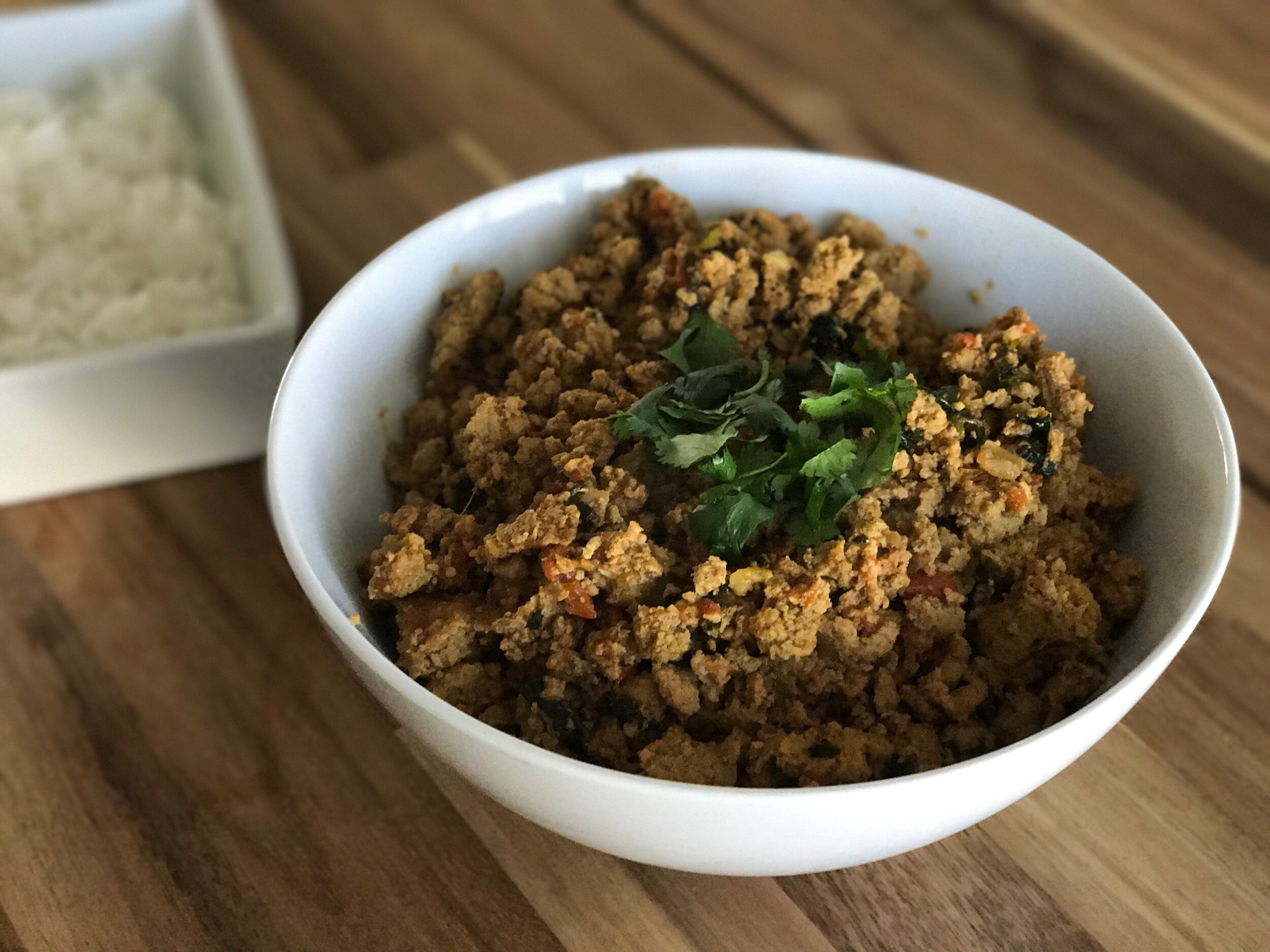
Keema Curry Recipe
If I were to choose one Indian dish I would consider my favorite to cook and eat, I'd have to say keema curry. It's such a simple dish to make and I haven't met a friend that didn't like it.Most of our friends have been initiated into our almost Indian family with this meal. It's full of vibrant flavors and who doesn't like meat and potatoes. For real.. It's so good.This dish is perfect for those busy school weeks too! All you need to do is prep all of your ingredients and let it simmer in a pot while your kids get homework done or you take a few minutes to put your feet up after a long day.If you're feeling extra fancy or you want an on the go dinner, you can make keema stuffed parathas! Follow the paratha recipe and replace the mixture with the recipe below. Voila, dinner you can hold in your hand.It doesn't matter how you choose to eat this, it's so good!
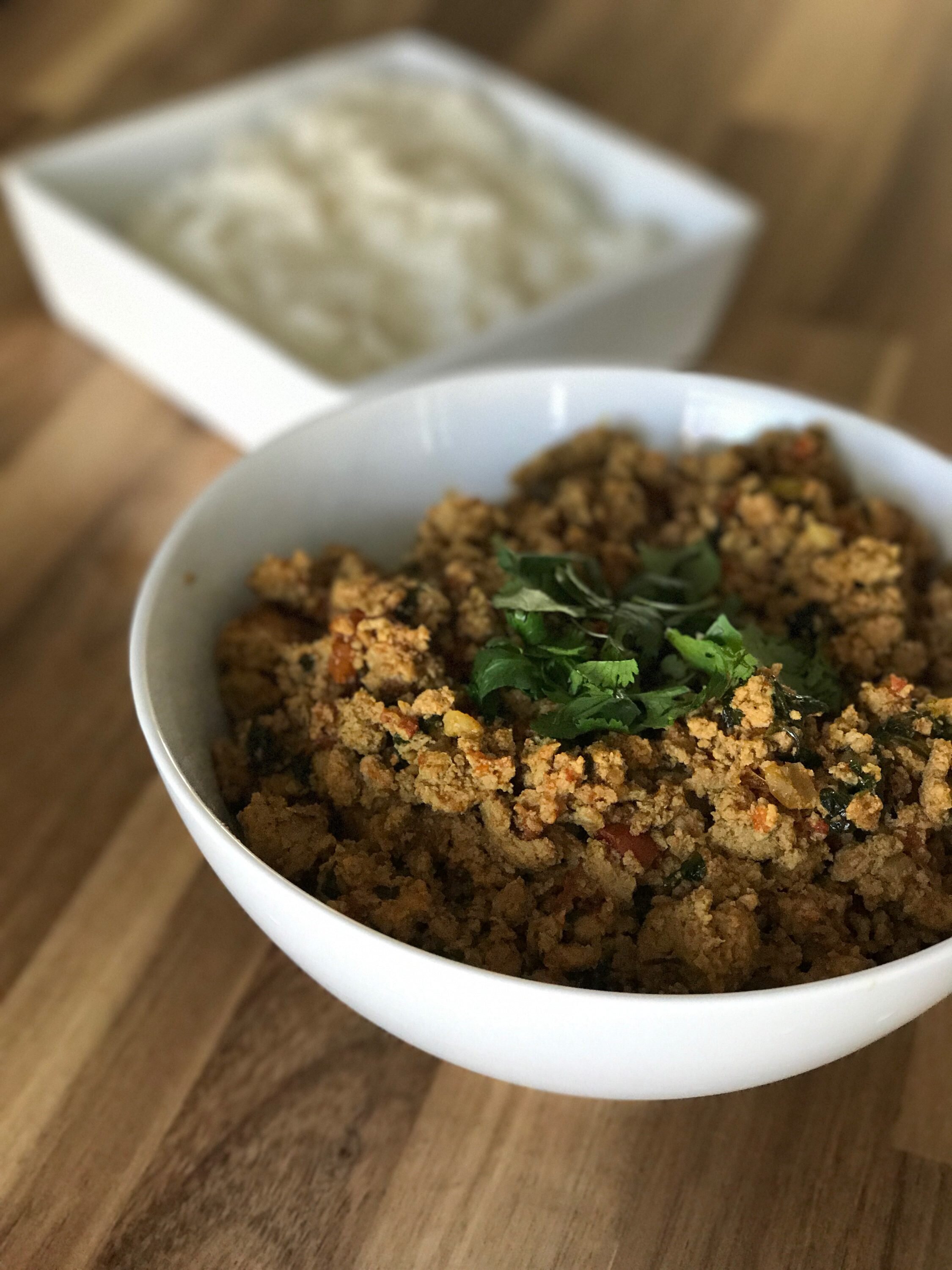
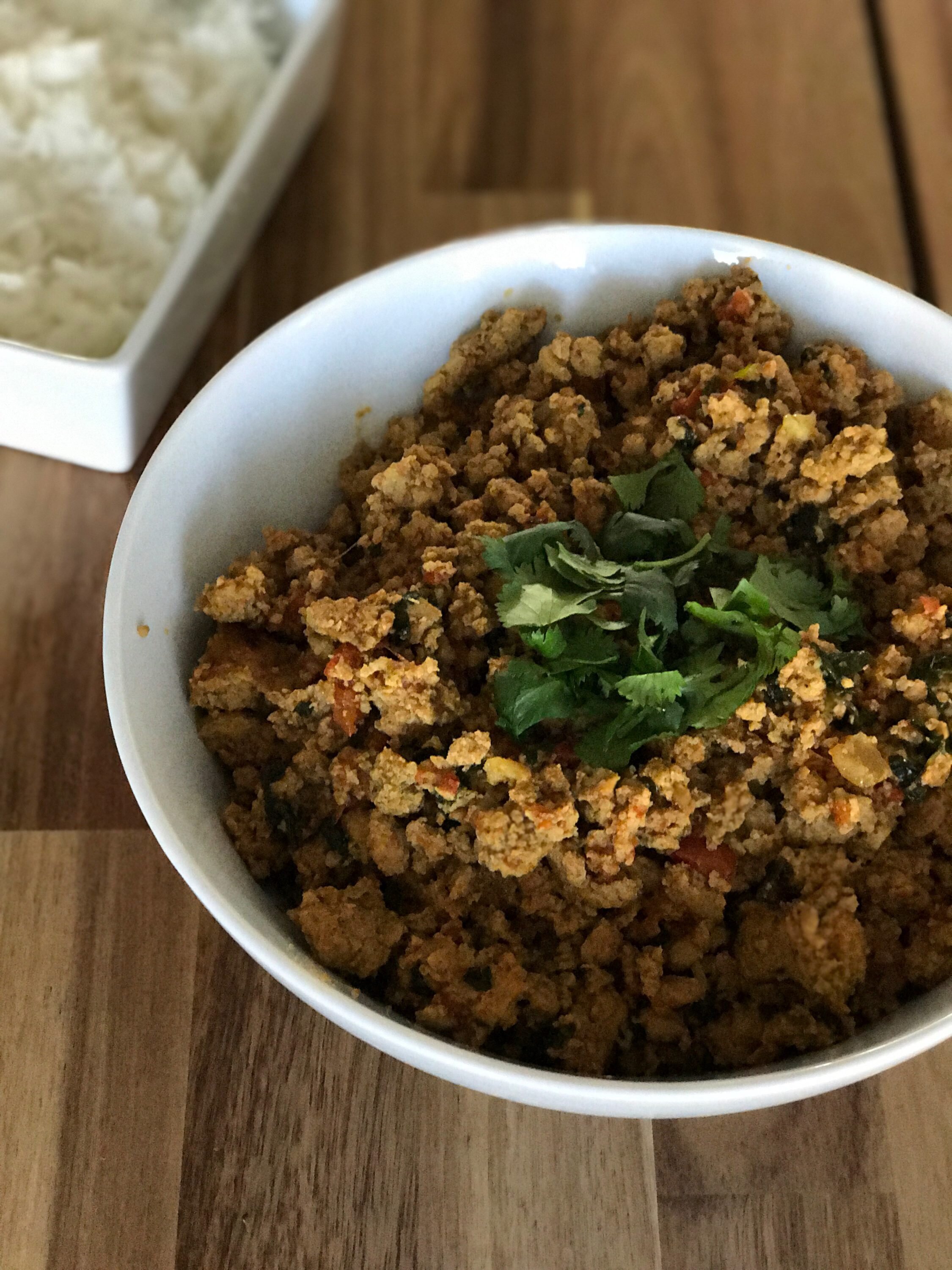
20+ Easy Indian Recipes
Are you looking for a few new recipes to try? Check out my round up and see all of my favorite Indian recipes!

20+ Of My Favorite Indian Recipes
I want to make it easy for you and to prevent you from finding disappointing Indian recipes online! Here are a few of my favorite Indian recipes that have been passed down to me from my in laws. They're delicious and simple to make!
Simple Indian Dinners
Almond Chicken CurryChicken Tikka MasalaBaked Tandoori ChickenSamosa Hand PiesTraditional Butter Chicken RecipeLahori Fish FryKarahi ChickenSimple Pav Bhaji (Vegetarian)Keema Curry
Sweet Indian Desserts
Indian DonutsVermicelli KheerMango Lassi SmoothieChai Spiced Donuts
Tasty Indian Side Dishes
Cumin Salad DressingGarlic NaanHyderabadi CabbageCoconut Green BeansCoconut Chana MasalaKhichidi Lemon RicePappu
Which one is your favorite?
Don't forget to PIN this round up for later!

Sarla In The Sky: Kid Review Addition
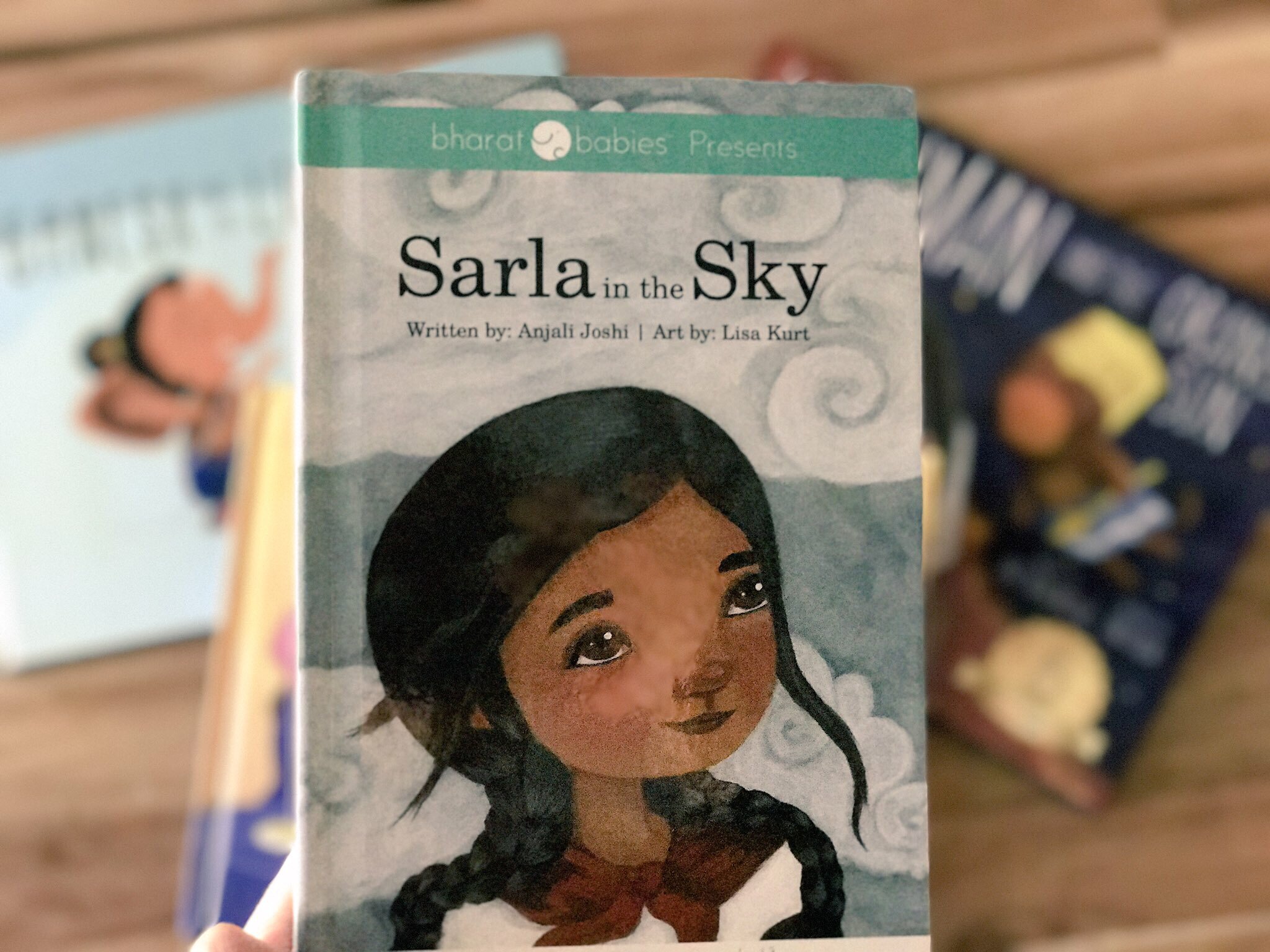
This post is sponsored by Bharat Babies. As always all opinions are my own.
The Best Part Of Women's History Month
Throughout the month of March, my kids and I have been diving into history. My boys have learned about so many influential women in history. They've learned about Helen Keller's determination, Sacagawea's adventures, Harriet Tubman's courage, and Mother Theresa's compassion.I love watching their little eyes light up as we dive into new adventures. This month has taught them so many things! They know that women can do anything they set their minds to and have even seen how courageous women have changed our world for the better.The best part is how it's inspired them!
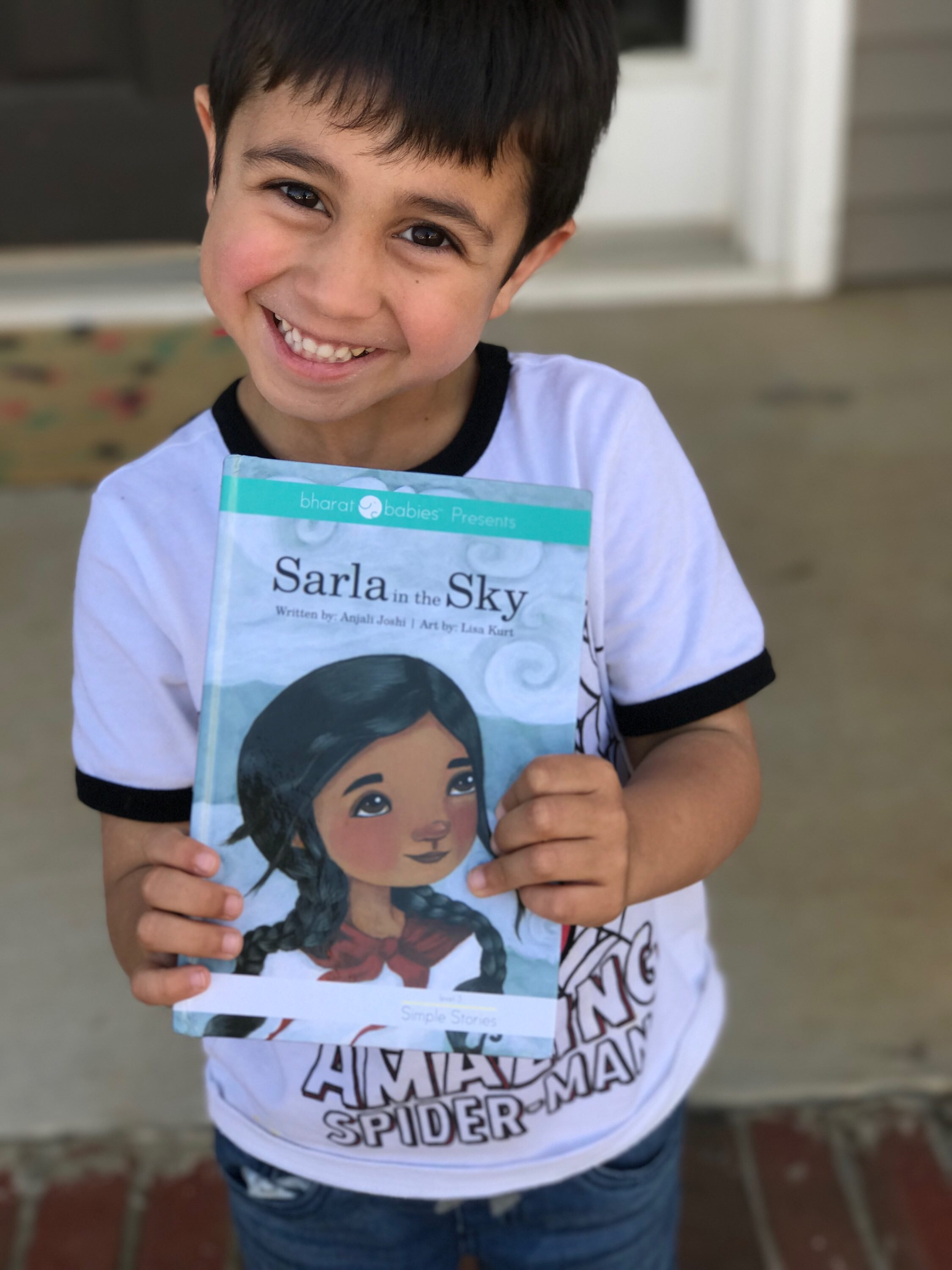
Let's Meet Sarla!
One of our favorite women in history is Sarla Thakral. She was the first Indian women to become a pilot! Her story is beautiful because despite all odds, she flew!Women have been told throughout history that they aren't as good as men. Social standards have told them that some things should be left for men. Sarla was a woman and living in India. Women are still struggling for equality in different parts of India so imagine how it must have been for her years ago!I was so excited when I found our new book, Sarla In The Sky. I've been obsessed with Bharat Babies' Books for a while now and I couldn't wait to get my hands on their new young reader book!My kids were just as excited! They eagerly checked the mail every day while we waited for it to arrive.
A 5 Year Old's Book Review!

Fun Facts About Sarla Thakral
After reading Sarla In The Sky, my kids wanted to learn more about her and her life. We had learned so much throughout our new book and were thirsty for more! Here are a few of our favorite facts!Sarla's plane was called the Gypsy MothShe had to log thousands of flight hours to get her pilot's licenseShe was born in 1914She was 21 when she got her pilot's licenseShe flew the Gypsy Moth in a sareeShe had a daughter
Learn about Sarla's story on your own and pick up a copy of Sarla In The Sky today!
Our Favorite Movies Featuring Interracial Couples

Sometimes A Good Movie Can Fix Everything
I'll never forget the month leading up to my big Indian wedding. For the first time in my life I was experiencing things I never expected to. I was trying to blend cultures and traditions for one of the biggest days of my life.It wasn't just about a wedding dress or favors, we had to figure out which culture to let navigate through wedding preparations. We ended up with a beautiful fusion wedding and it was worth all the long hours it took to make it happen.When things would get stressful, I'd cozy up on the couch with a good movie. I found myself looking for movies with interracial couples who understood what it meant to blend cultures.Can you guess what movie I watched over and over again?My Big Fat Greek Wedding!Replace Indian for Greek and you have my life, wedding, and story! I know it sounds silly, but it feels good to watch a similar story to your own. It's comforting.If you're looking for a good movie about interracial couples, I have the perfect list for you! Cozy up with some popcorn, your loved one, and pick one of these for your movie tonight!
My Favorite Movies Starring Interracial Couples
Loving
Hitch
Away We Go
I Love You Man
Focus
Hancock
The Words
Belle
Guess Who
The Wedding Planner
Save The Last Dance
Fools Rush In
My Big Fat Greek Wedding
Which one is your favorite?
Multiracial Motherhood: How Can You Bring Families Together?
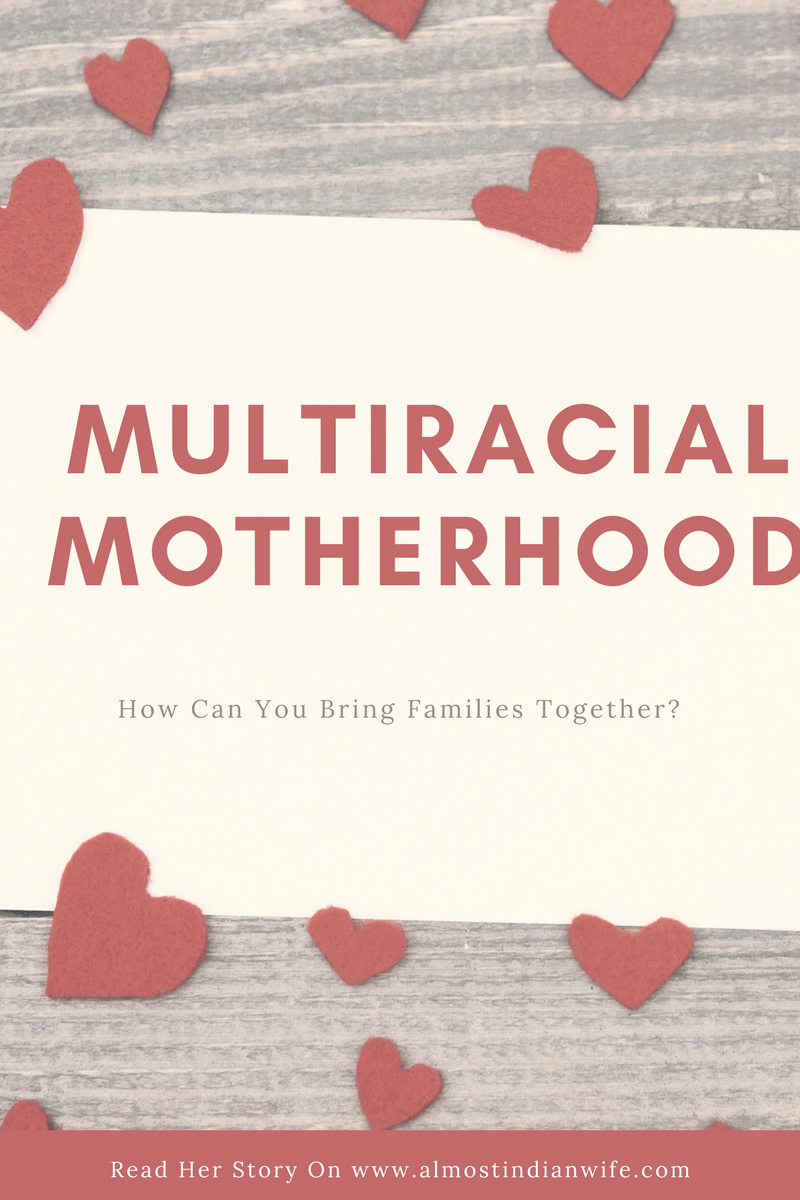
What Can We Learn From One Mother's Story?
Happy Friday!Fridays are my favorite for so many reasons. They mean my husband gets to be home all weekend with us, they mean family night, and they means another mother is joining us for Family Fridays!This series is so special to my heart because it’s a chance for mothers to come together and share their experiences with their own multiracial family. The beautiful thing is that all of our families are unique. They all have their own special qualities, unique challenges, and different experiences.Today, Larisha from We're Parents blog is joining us! She's going to share about her multiracial family and one thing she's found that can bring all families together!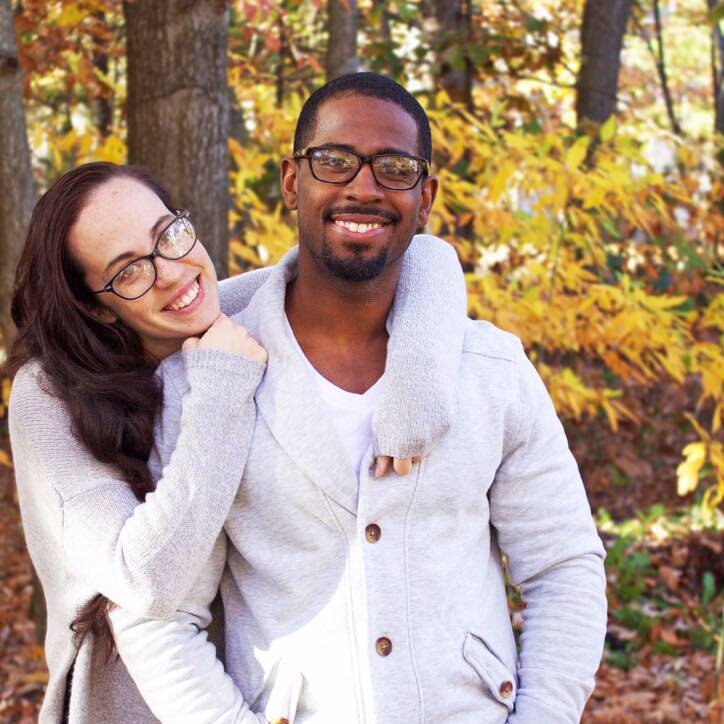
Let's Meet Larisha!
Hey y'all! I'm so excited to have the opportunity to share a bit about our family with The Almost Indian Wife crew, thanks to Brittany.Let's start with a bit of a background.I'm Larisha, a Caucasian American, born and raised in the hills of West Virginia. Andrew, my fiance, is a Jamaican American, born in Brooklyn, raised in New Jersey. Together we raise our two young daughters in New Jersey, just a short drive from where he grew up, while running our website, We're Parents, together.
Now let's rewind a bit.
Andrew and I met in 2005 during a History class freshman year at West Virginia University (Go 'Eers). The chemistry was always there, but I had a boyfriend and it wasn't until 2009 that we officially started dating. I was working on my Masters and he had just finished up his undergrad degree. He was moving back to New Jersey and we dated long distance for 3 months, then we decided that he would move in with me (WHOA, that was fast!). A few months later, we moved to New Jersey, and the rest is history (pun intended)It's been a whirlwind of an adventure and while we could tell you the stories of people asking if the girls are biologically mine, or the looks that we've received over the years while holding hands, you've probably heard all of that before or most likely experienced it yourselves.Today, I want to focus on how we've blended our cultures together SLOWLLLYYY. It was really important to me for his mom to like me. I knew she was hesitant about me. Andrew quickly informed me that if she wanted me to understand what she was saying, she would speak so I could understand. If she didn't, I wouldn't. His family speaks a strong dialect of Jamaican Patois, and while 90% of the time at this point in our relationship I can understand them, this advice still holds true to this day. Luckily, he did let me know earlier on that based on how she spoke to me, he knew she liked me.

The key -Food. No seriously.
Alan D. Wolfelt once said,
Through everything, his family has taught me about joy, togetherness, and the amazing bond that a family can having, bridging two extremely different cultures, one meal at a time.
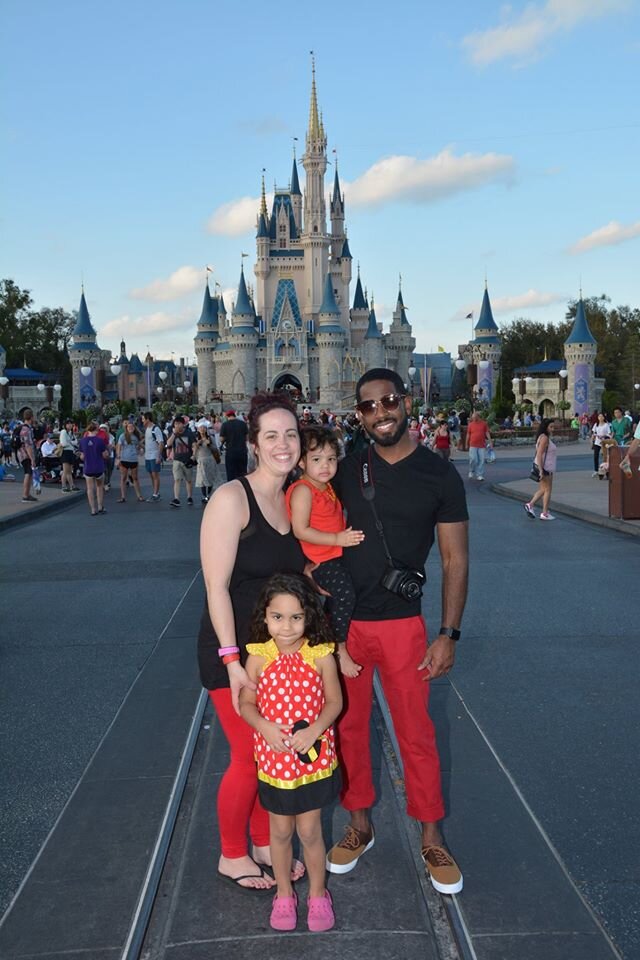
Stay updated with Larisha by following her here!
Almond Chicken Curry With Utha
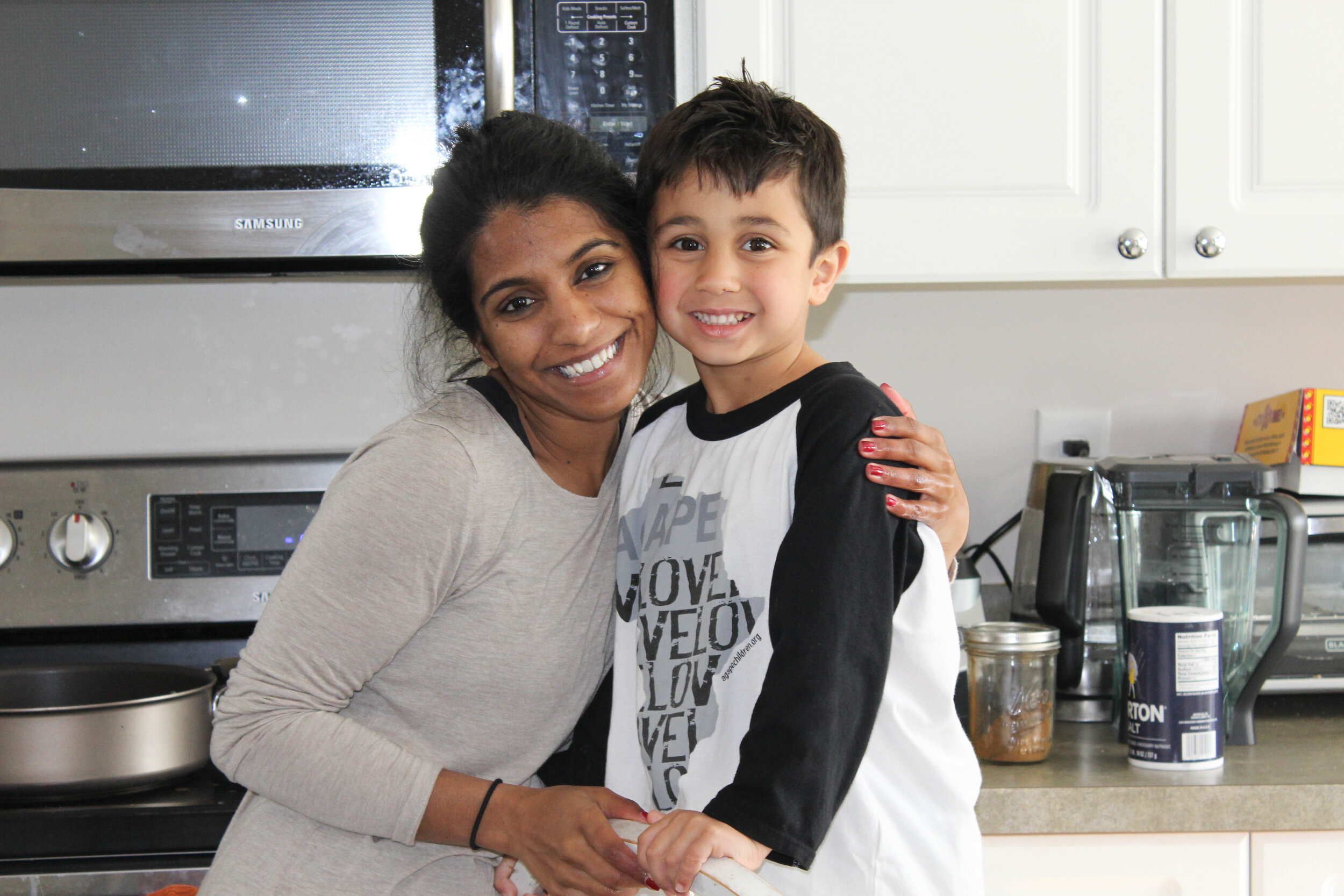
Welcoming our first guests in our new home!
We've been in our new home for about a month now. It's been a crazy ride moving to North Carolina, but we're already loving it. This week we even had my sister in law and her husband come visit!Krystal and Will have been married for a little over a year now and also have an interracial marriage like my husband and I. It's been so much fun watching them navigate multiple cultures and seeing how eager and excited Will has been to dive into Indian culture.My kids have been counting down the days until Krystal-utha and Will-mama get here. They couldn't wait to show off their new house and spend time with some of their favorite people. The kids even planned out their whole time here!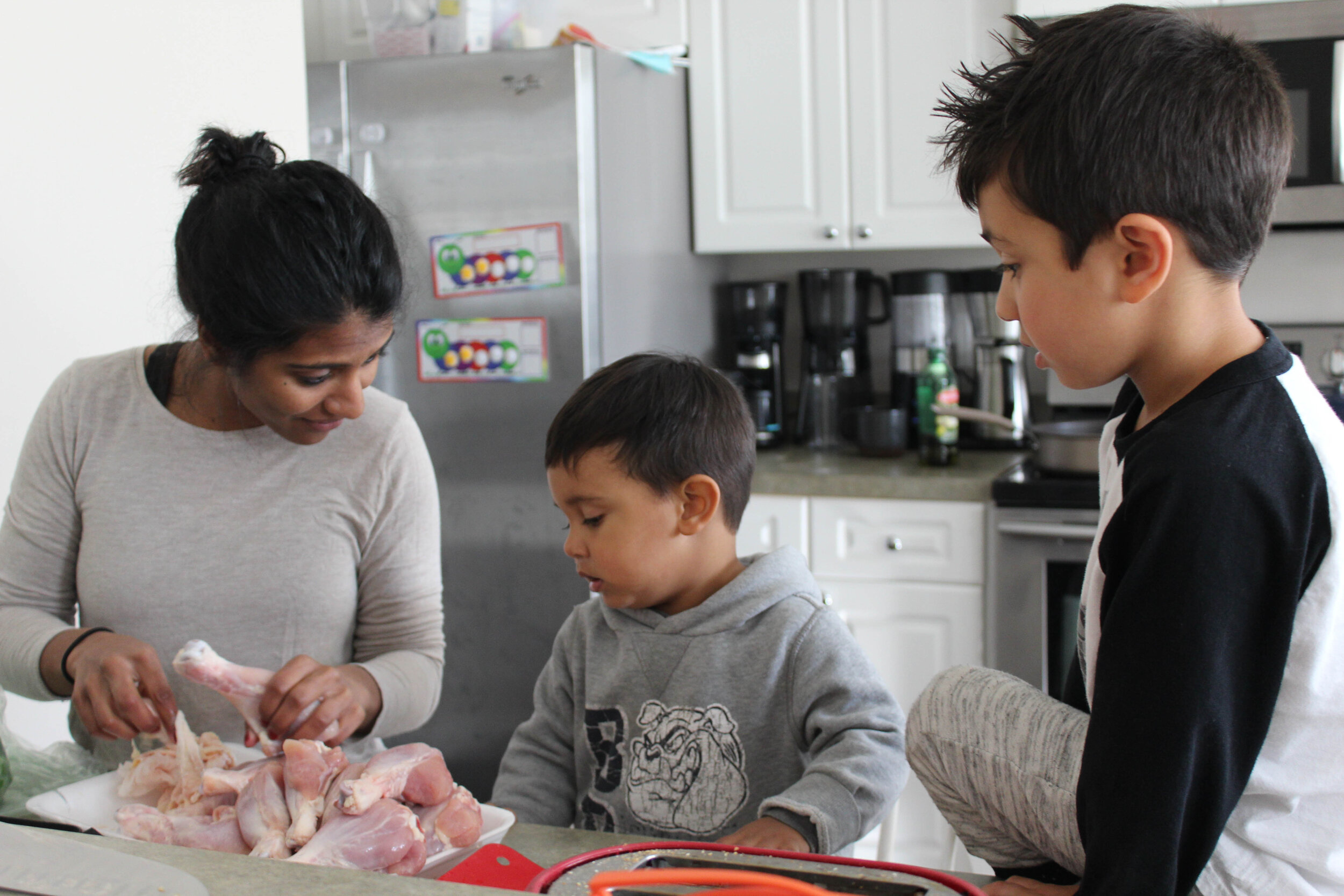
Cooking With Utha
One of the things Liam was the most excited about was to help Krystal-utha make almond chicken curry!Trust me, it's as good as it sounds! If you've had Indian food before, chances are you've tried chicken curry. This dish has a little twist to traditional chicken curry because my sister in law adds a few unique ingredients.I love learning how to make different Indian dishes because the person making it always has a unique touch. My mother in law uses coconut in her chicken curry and my father in law uses tamarind. They're all delicious but you can always tell who makes it!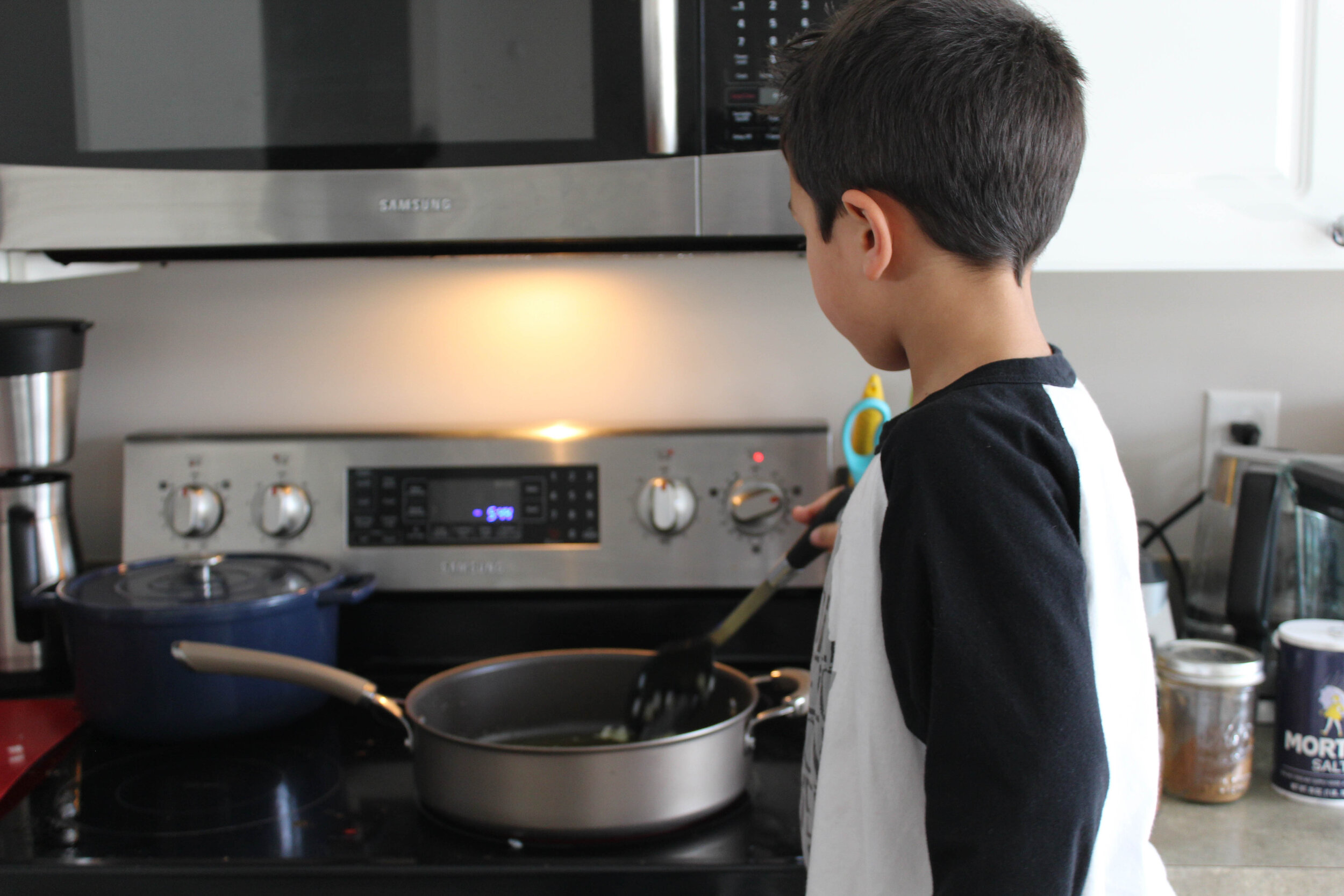
Liam is always my little chef in the kitchen.
He wants to know how to make everything and always asks to try it on his own. It makes me wonder if his passion for food will turn into something as he gets older.Although right now he's decided on becoming an astronaut!The whole time his Krystal-utha was making her almond chicken curry, he wanted to know why. Why are you adding the onions now? Why do you add so much chili powder?Why is it so hot?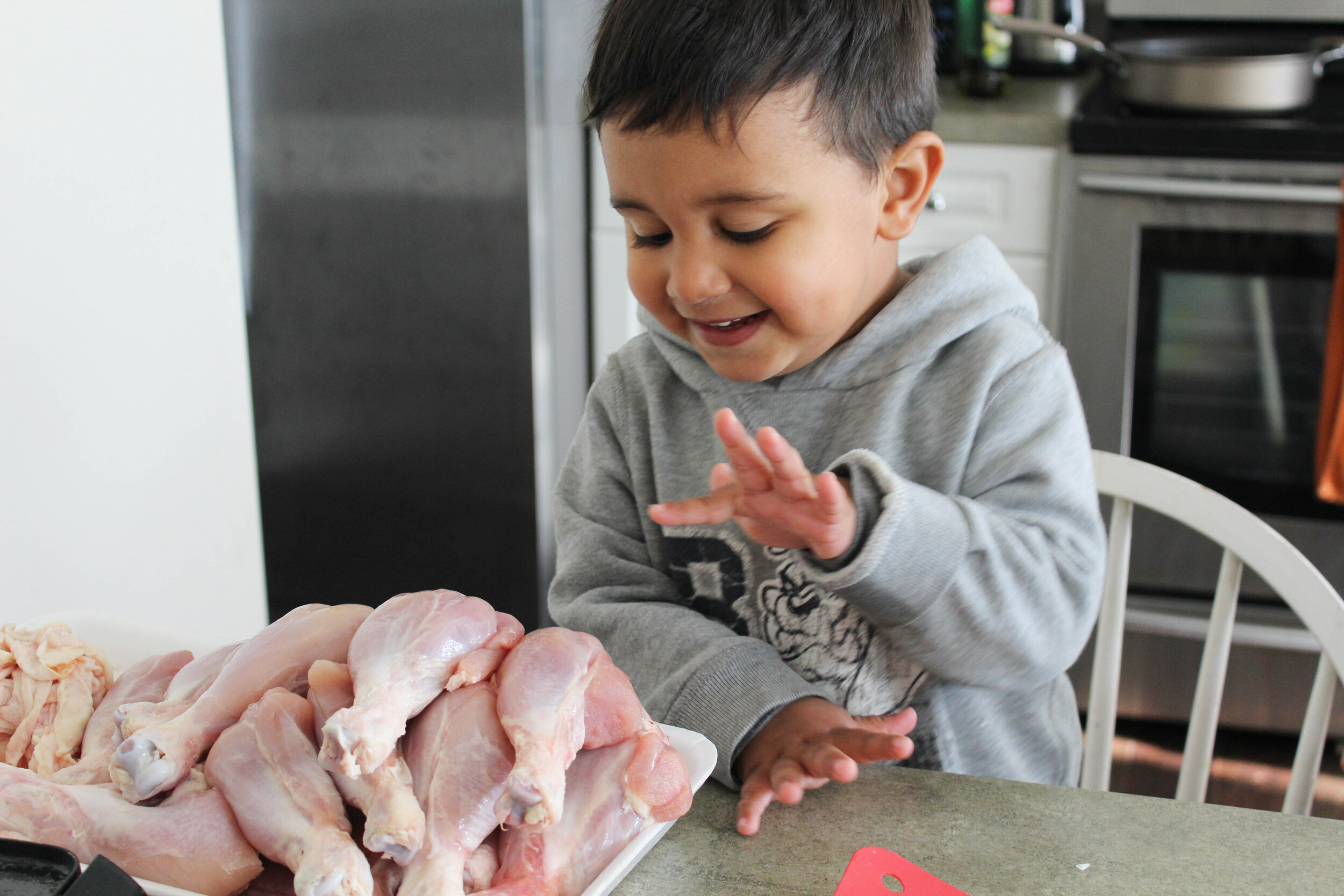
Baby Luke couldn't help but join in on the fun.
He started asking what he could touch. He was dying to touch the chicken because it was the one thing Krystal-utha asked him not to! As you can tell, the temptation was just too much to handle!All in all it was a special bonding moment for all of them. Liam and Luke were able to learn a few things about cooking a traditional Indian dish, Utha got to spend quality time with her boys, and we were all blessed with a delicious dinner!


Preparing For A Move With Kids
This shop has been compensated by Collective Bias, Inc. and its advertiser. All opinions are mine alone. #PureLife40pk #CollectiveBias
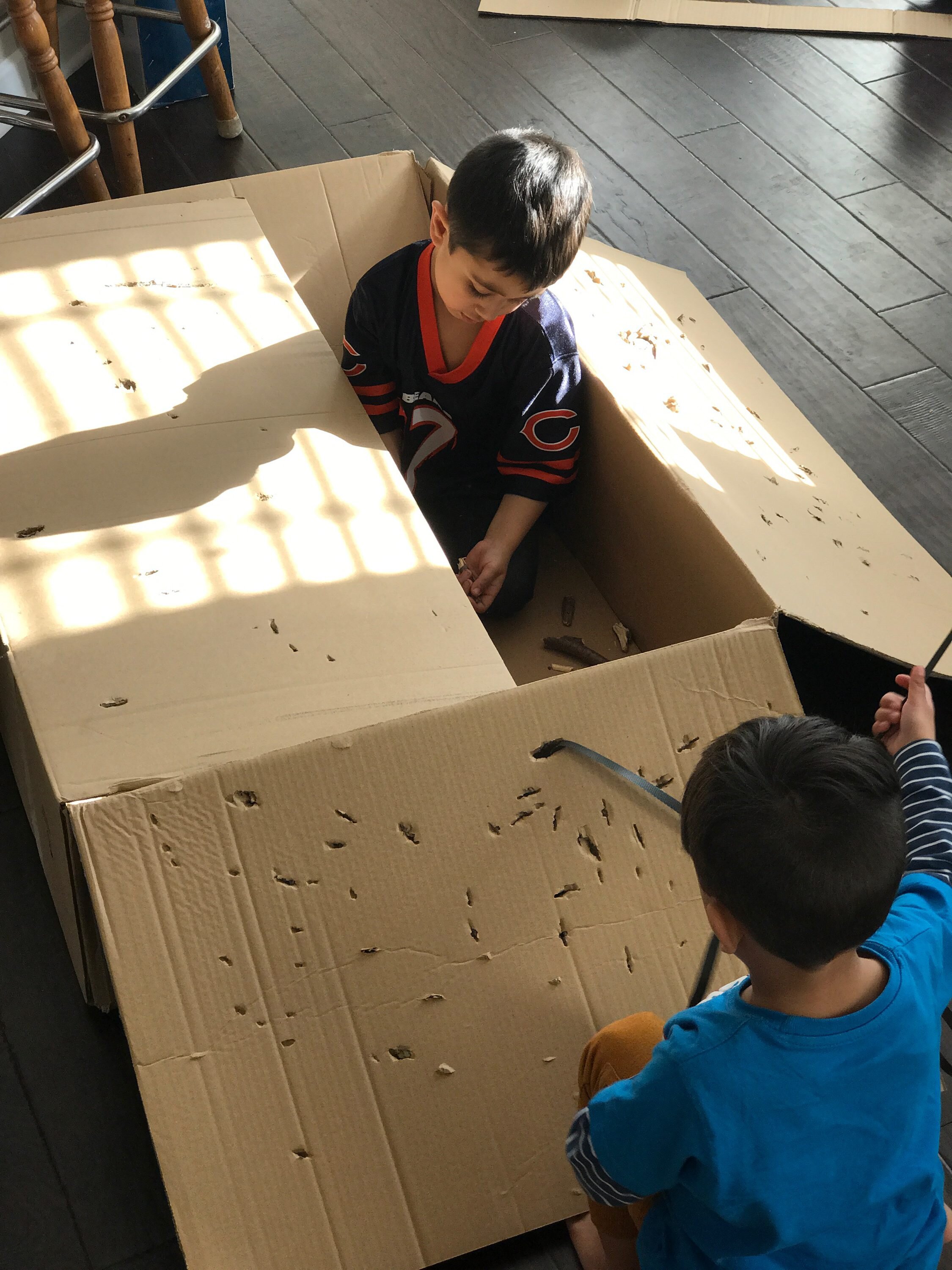
Preparing For A Move With Kids
Over the last seven years, my husband and I have moved our family a total of 3 times. We've lived in four different states which means we've had to move our lives three times!We've learned quite a few things through trial and error. You know how it is when you move... You get so exhausted that you start cutting corners, only to end up at your new house with no idea where anything is. If you're not careful you end up in this predicament for much longer than expected!
Simple Tips To Follow For Your Next Move
Don't worry, I have a few tips for you that will make your next move a cinch!
Leave one small box of the kid's favorite toys out until the very last day
As you start packing up each room, be sure to leave out your kid's favorite items. In our house, this was a few stuffed animals, a building set, books for bedtime, cars, and some superheroes. It helped to reduce the mess by only having one box of toys and it was comforting for the boys. They were watching their home be packed away, but their favorite toys were by their sides.
Use plastic tubs instead of boxes
Boxes are nice, but at the end of the move, you're stuck with dozens and dozens of broken down boxes. This time around, we learned from the past and picked up a few dozen tubs. They were a bit spendier than picking up boxes, but made moving so much easier! They stacked on top of each other beautifully!
Label Label Label
The biggest headache is arriving at your new home and not being able to find anything! This is why labeling is so important. Label to the point you think you're overdoing it because I can promise you, you're not!

Stay Hydrated
The best thing you can do for your whole family while moving is to keep them hydrated! It helps keep their energy up, helps their body fight new sick bugs, and makes for much happier kiddos. Moving takes a lot out of your body so be preventative and keep them hydrated the entire time.
Put all of your essentials in the same box and label them so you can find them right away
There are always a few items you will need as soon as you get to your new home. Put all of these in 1-2 boxes and label them so you can find it easily.
Keep Hanging Clothes On The hanger
Use a garbage bag to hold all of your clothes on hangers. This way you can transport it easily without having to take them off the hangers. It means one less thing to do!
If you're breaking down furniture, keep all the pieces in one place
When you're breaking down furniture, you end up with dozens of little screws and bolts. Put the pieces for the furniture in a separate baggie. Then take all the bags you end up with and put them in a small box or container. This way there's not a way to lose pieces you need later!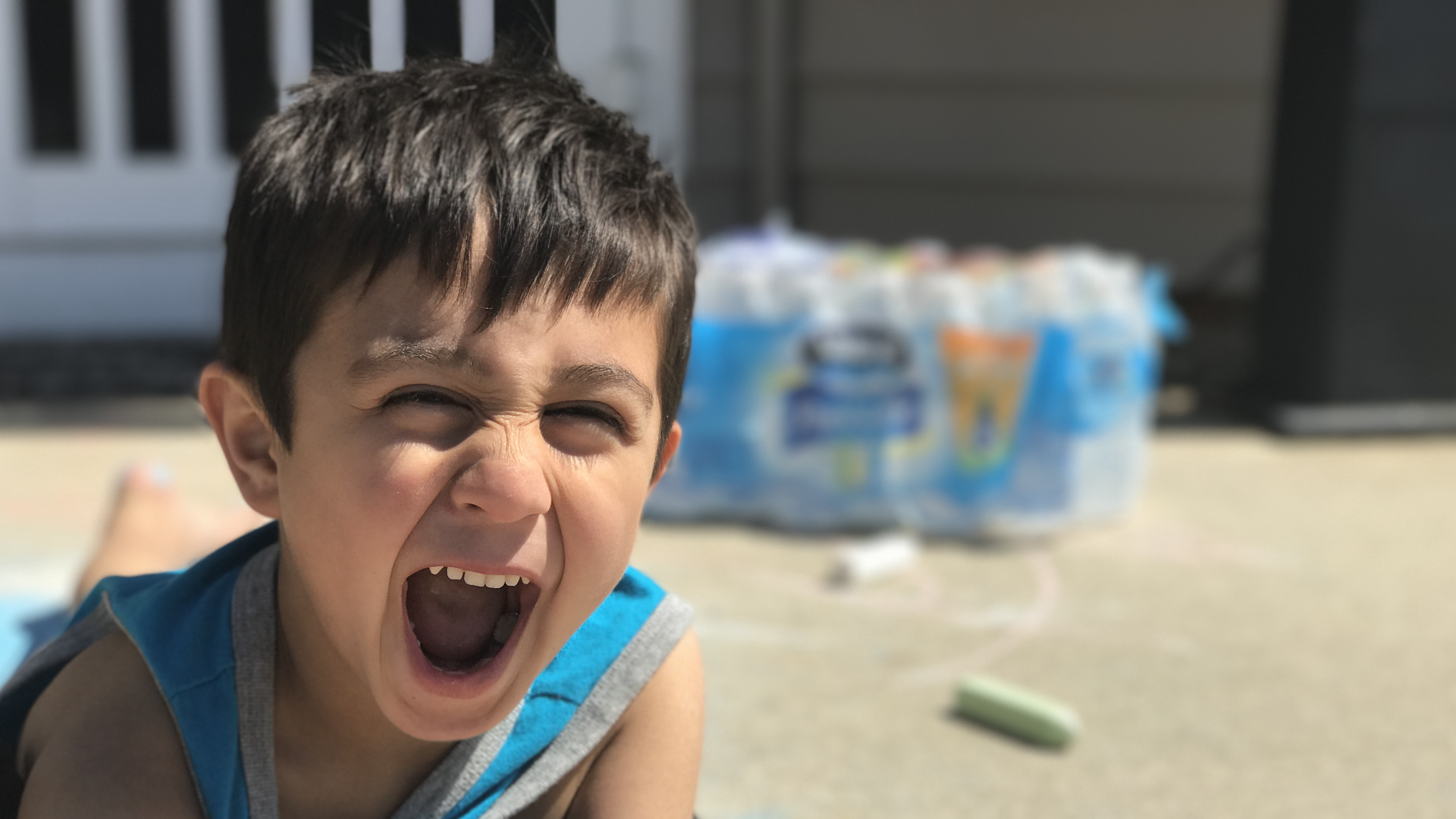
Let the kids play outside
As your packing up the house, the worst thing is for the kids to get into boxes and start taking things out. Do yourself a favor and try to get them to play outside as much as you can even if that means you pick up a few cheap outside activities like chalk
Offer delicious food to people that help you move
Finding people to help you move can feel impossible. In reality, who wants to spend their whole day lifting boxes? All you need to entice them is some delicious food! Pick up some good snacks and tempting food.
Purge when you can
When you move you realize just how much junk you've acquired over the years. This is your opportunity to get rid of anything you haven't use in the last six months or can easily replace at your new house.
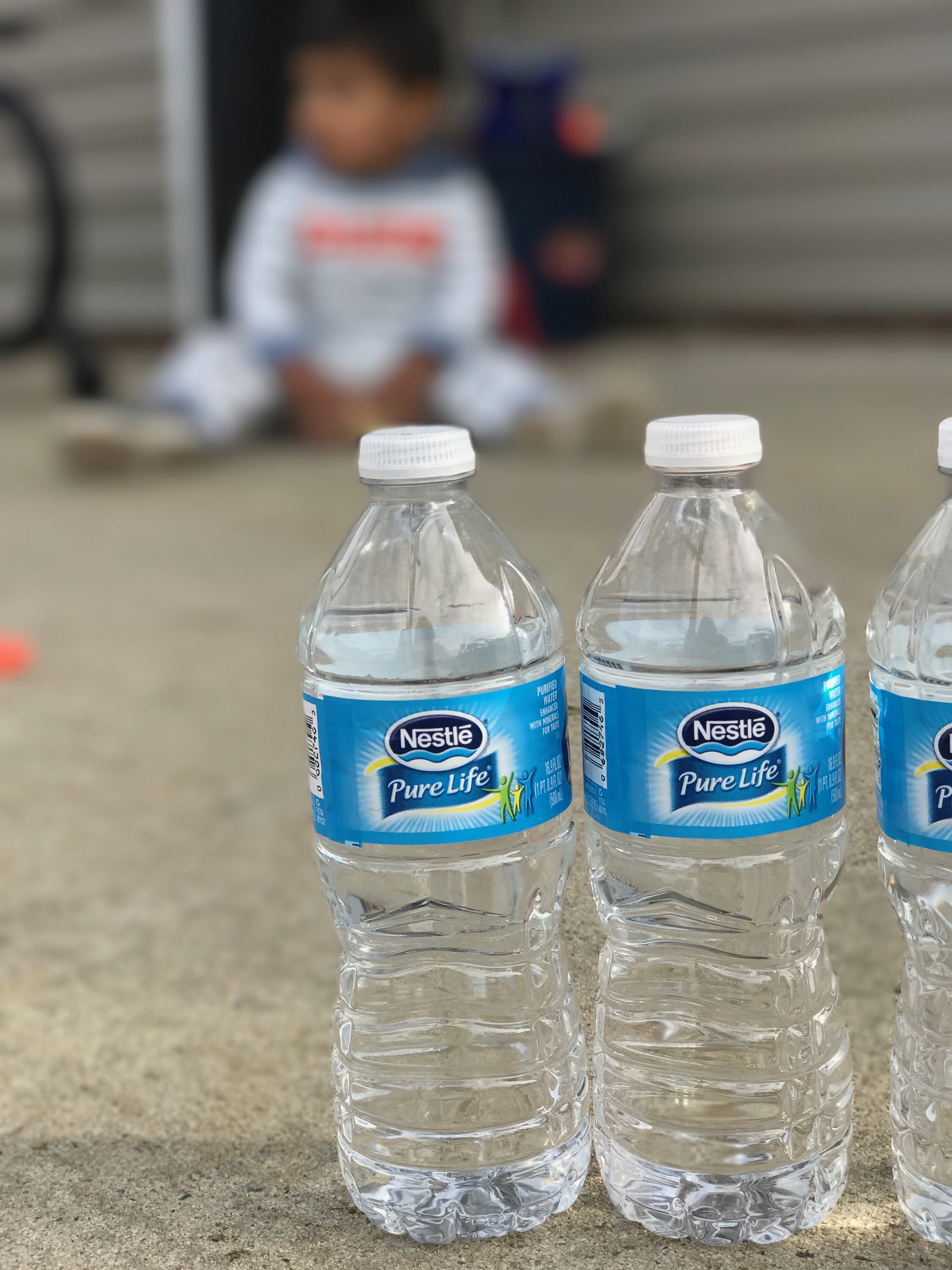
Start Your Next Moving Adventure With Nestlé® Pure Life® Water
Before you begin your next moving adventure, head to your local Sam's Club and pick up a case of Nestlé® Pure Life® Water. They're offering 40 bottles for the price of 35!
 Nestlé® Pure Life® Water knows how important it is for a family to stay hydrated while moving. It's their goal to provide the best water for families. They even put their water through a 12 step process to make sure they're water is just what you need.Available in select Sam's Club stores, ask your Club Manager about getting Nestlé Pure Life Water in your store if it's unavailable.
Nestlé® Pure Life® Water knows how important it is for a family to stay hydrated while moving. It's their goal to provide the best water for families. They even put their water through a 12 step process to make sure they're water is just what you need.Available in select Sam's Club stores, ask your Club Manager about getting Nestlé Pure Life Water in your store if it's unavailable.
Lessons My Biracial Children Need To Live By

The Responsibility of Being A Mother In A Multiracial Family
I always knew there would be a lot of responsibilities as a mother, but I had no idea how much it could be.As a mother, it's my responsibility to raise my kids to be strong and independent men. I want them to be confident in who they are so they can weather any storm they face in their life.My kids are biracial. They're trying to figure out who they are as Indian and Caucasian young boys. I love watching them navigate through both cultures. They have their whole lives to to figure out their biracial identity and right now it's all about the journey. They're figuring it all out one year and one step at a time.There are so many things I want them to know as they start to figure it all out. As their mother, I feel a lot of pressure to make sure it all sinks in.We tell our kids things every single day. Don't leave your socks on the ground. Don't be mean to your brother. Use an inside voice. It doesn't matter how often we say it because we'll continue to say the same things until the finally sink in.The reality is some may not. They may end up getting married and their wives are still yelling at them about their dirty socks on the floor.**Am I right ladies!?**As I watch my little boys sleep next to me on the couch, I realize out of everything there are a few things I hope and pray will sink in.
Lessons I Want My Biracial Children To Live By
Believe In Yourself
At the end of the day your kids need to be their own motivator. They need to believe in themselves so much that they don't let people put them down. Their confidence can remind them they can do anything they set their minds to.
Your Unique Qualities Are What Make You Special
As biracial kids, it's easy for them to see their unique qualities as a hindrance. Kids want to be like their friends so they don't stand out. As a mother to biracial kids we need to teach them how special those differences are. We have to help them take pride in what makes them unique.
You Will Meet Ignorant People And That's Ok
As much as we would all love to keep every ignorant person away from our child, we can't Some people will say ignorant comments to our kids and that's ok. It's an opportunity for them to challenge it. They can teach people more about their culture instead of letting their comments make them upset.
You Can Make A Difference
As a biracial child, our kids have a unique perspective on life. They will see the beauty in diversity. We need to ingrain into them that they can make a difference. All they have to do is let their courage fuel them and they can do anything.
We Love You Regardless Of Which Side You Identify With More
A struggle many biracial kids deal with is identifying more with one of their cultures. Often times it's due to which culture they are around more and that's ok. We have to give them the freedom to figure out their biracial identity on their own. As much as we would love it, there isn't anyway for them to have a perfectly balanced biracial identity.
Stand Up Against Things You Know Are Wrong
As our kids grow up, we need to show them what it looks like to stand up against prejudice and racism. Sadly it's going to happen whether we like it or not. We can't prevent it, but we can stand up against it. As our kids see us lead by example, they'll be more likely to do it when we aren't there.
People Have Fought For Your Rights, Don't Squander It
Throughout the years many people have fought for the rights we have today. It's hard for kids to see this at time because their used to their freedom. The Lovings fought for multiracial couples like us. They stood up in a time where people said interracial couples didn't belong together. It's our job as mothers to remind our kids to be grateful and to take advantage of the opportunities they have today.
Hate Doesn't Solve Anything
One of the hardest things to witness is prejudice and racism. It stirs up the momma bear in all of us because we know how much it hurts our kids and our own multiracial families. We need to teach our kids that responding in hate won't change anything. It makes us all angry, but hate is what caused it in the first place.
Love And Knowledge Are Powerful Weapons
Hate has caused so many of the terrible things in our society. It's caused people to say hurtful things and even as terrible as committing hate crimes. We need to teach our kids to respond by teaching people about new cultures and how to love each other. Ignorance fuels prejudice and racism so knowledge is key.I am always reminding my kids to teach their friends about Indian culture because most of the mean comments they've said to my kids are because they're not used to Indian traditions. They see my kids eat Indian food with their hands and make fun of them. They don't realize it's because it's what Indian families do.If I had to choose one thing to teach my kids above all else it would be this. Fight hate and racism with love and knowledge.
What do you want your biracial kids to know?
Multiracial Motherhood: Our Multiracial Family Through Adoption

What We Can Learn From One Mother's Story
Happy Friday! I thought we could kick off the weekend by starting up one of my favorite series again!Family Fridays!This series is so special to my heart because it's a chance for mothers to come together and share their experiences with their own multiracial family. The beautiful thing is that all of our families are unique. They all have their own special qualities, unique challenges, and different experiences.Today, my lovely and gorgeous friend Sara is sharing about her mixed race family. They have taught my family and I so much about diligence because Sara goes out of her way to make sure their lives reflect a true multiracial community. Check out more about her story below!
Let's Meet Sara
Hello, everyone! I'm Sara and I am excited to be here at The Almost Indian Wife to share a little bit about my family with you! Our situation is a bit different than the ones you may be used to reading about here, in that our family's multiracial "status" did not come about because of my husband or myself, but because of our children. And before I dive in, can I confess something? I don't always feel like we really are multicultural. Do we want to be? Yes! Are we working toward it? Yes! Do we still have lots more to learn? GOOD GRIEF, YES. And that's why I think connecting with other multi-cultural families is such a cool thing! Okay, back to the introductions...My husband, Phil, and I have been married for almost nine years now and we have two children. We lived in Ohio up until the spring of 2016 when we moved to Illinois. Phil and I were foster parents for four years in Ohio, during which we met and then adopted both our daughter and son. Russell (5 years) is African American and Claire (4.5 years) is Caucasian. Our children are not related biologically (yes, some people ask!) and have very different birth stories and foster care experiences. 
One thing my children do have in common though, (among plenty of other things, trust me) is that they have two parents who acknowledge and celebrate the things that make each of them unique.
Speaking of unique, let's talk culture. What exactly is culture anyway? Here's one definition: "The customary beliefs, social forms, material traits of a racial, religious, or social group;" also, "the characteristic features of every day existence shared by people in a place or time." Reading those definitions reinforces a couple things to me. One: The racial majority in our family is white American. That seemed so silly to even type but there it is. And let's be real, white American culture is not one we have to make an effort to call attention to. Ya know?
Two: If we want to be truly multi-cultural -- embracing, celebrating and participating in our son's racial culture -- we have to be intentional.
Neither my husband nor I are African American. And although our son is, he's been with us since he was two months old. Our white American culture is pretty much all he knows. So we have some work to do! What does this intentionality look like for us? Well, for starters, whenever I have the choice I choose African American. That might sound funny or off-putting but hear me out. It's not that we don't welcome and seek out other cultures. We absolutely do! But I'm here today talking specifically about my African American son and HIS culture and our desire for him to have racial mirrors in his life. If we want to raise a young man who embraces and is secure in his African American identity, he specifically needs African American people in his life. Okay, here's what I mean...Our community here in Illinois has a kids' sports program. So does the neighboring community. We're choosing to drive just a couple extra minutes to the neighboring community because it's more diverse. We figured there's a greater chance there for our son to have teammates and opponents and coaches who look like him than if he were playing on a sports team here. (Why didn't we choose to live there instead when we moved from Ohio, you ask? We wonder the same thing some times. Anyway...)When looking for a church to join, diversity was a priority for us. After Biblical teaching and gospel-centeredness, we looked for a place where our son could walk in and see people who looked like him. And not just in the pews, but on the stage speaking. In the classrooms teaching. In the small groups leading. When selecting books and toys for my kids, it's not difficult to find white baby dolls and white story characters and white action figures. In fact, if you're not purposely trying to avoid a whitewashed book and toy collection, you'll most likely end up with one. So when strolling through the store we see a giant Finn action figure (Star Wars main character who is African American- woo hoo!!), I snatch it up. A black baby doll for Claire? Yes, please. A picture book with black main characters instead of white ones? You get the idea. Now you might find this one silly, but I'm okay with that. When checking out at a store and I have the option (if it's not an insanely packed lane versus a totally empty one) I will choose a lane with a non-white cashier. 
We take our son to a black barber.
(A no-brainer.) This choice doesn't mean just one more racial mirror for my son. Every barber and almost every client there is African American. So, it means many. It means my son gets to be the majority. And my daughter and husband and I experience what it's like to be the minority. It means sitting and talking with people who share my son's culture. People who will tease me for never having seen "The Jeffersons" and who graciously and honestly answer my hair care questions. I'm telling you, walking into that shop where we are greeted by a packed room of 100% brown and black faces makes my heart swell with joy. Because the more we can immerse ourselves in African American culture, the more our family moves toward being truly multi-cultural. One more piece of advice. More important than all the little examples I shared above!
When seeking to embrace a culture that is not your own you have to first humbly acknowledge that you are not an expert.
And then start sharing your life with those who are! Become friends with people who are a part of your loved one's culture. Spend time with those who can help you understand the things you don't and who will lovingly correct you when you need it. I mean, read all the history you want; build the most diverse picture book library on planet earth; learn all the cultural traditions you can...but without real relationships with real people who know this culture, you will be missing out. And there you have it. We are a multi-racial family doing our best to recognize, embrace and encourage the unique identities of the precious children we've been entrusted with. We definitely don't have it all figured out but we're taking it one day at a time and learning as we go!


